
This is the first of three web pages describing amateur observations of a special white dwarf star. This web page describes observations from 2015 Nov 08 to 2016 Jan 21 (all by amateur observers). Observations from 2016 Jan 17 to 2016 Jul 13 (mostly by amateur observers) is described at http://www.brucegary.net/zombie2/. A fuller description of WD1145, and its significance, is found at the above web page.This web page is devoted to the first 2.5-months of photometric monitoring of white dwarf WD 1145+017 (a.k.a "a zombie star" in the popular press) by a small group of amateur astronomers for the purpose of characterizing transit features produced by dust clouds somehow related to asteroids in a close orbit around the white dwarf. The discovery paper by Vanderburg et al (2105) describes how Kepler K2 data (2014 Jul to Sep) led to the recognition that this star underwent periodic fadings at intervals of ~ 4.5 hours. Ground-based follow-up observations were conducted by the Vanderburg team during 2015 Mar/Apr, and also by Croll et al (2015) during 2015 May. The goal for the observations presented here was to characterize fade activity (presence/absence, depths, periods) and establish an updated transit ephemeris and assess depth trends prior to the intensive observations by professional astronomers in February and March, 2016. This web page describes observations during the period 2015 Nov 08 to 2016 Jan 21, which are the basis for a publication in MNRAS by Rappaport et al, 2016. I continued to observe after this publication cut-off date, and those observations, along with observations by others who joined me in April (covering the 6 months 2016 Jan 17 to Jul 13) are described on another web page: http://www.brucegary.net/zombie/. A publication describing the entire 8 months of observations (2015 Nov 08 to 2016 Jul 13) has been submitted to MNRAS; an arXiv version of it will become available on 2016 Aug 01.
WD 1145+017 (hereafter WD1145) has a mostly helium atmosphere
(with some hydrogen) that show many metal lines. The metal lines
indicate the presence of a continuous flow of dust onto the WD
surface (and rapidly sinking). IR fluxes out to 4.6 micron
wavelength reveal the presence of an "IR excess debris disk"
with an effective brightness temperature of ~ 1145 K and solid
angle of ~116 times that of the WD disk (Vandergurg et al,
2015). Kepler K2 observations show fade features that repeat at
4.500 hour intervals (the A period), 4.605 hours (B period), and
smaller amplitude fades with period as long as ~4.9 hours. The
K2 fade shapes and peak depths could not be characterized well
because the Kepler exposure times were 30 minutes. K2 depths
varied from <0.4 % to ~2.0% (based on 30-minute exposure time
data). It is speculated that at least one asteroid is
disintegrating and producing fragments that are the source of
the dust clouds (Rappaport et al, 2016).
Early results of the present observations show that some of the
fades are deeper than previously observed (i.e., fades of 60% of
the un-faded flux). When our light curves (LCs) are smoothed to
simulate the Kepler K2 observations (i.e., 30-minute averages)
the fade depths are dramatically greater than the K2
observations (1.5 years earlier) and also the professional
ground-based follow-up observations (o.5 years earlier). The
ratio of overall depth activity is as much as 25 times greater!
Another curiosity is that essentially all of the individual fade
events exhibit phase drifting to earlier times in successive
dates. An individual fade event can in this way be tracked for
many weeks, and possibly months. All of these new behaviors are
real, not observational artifacts, because whenever 2 or 3
telescopes produce overlapping LCs the fade features are seen in
all of the LCs.
The earliest observing sessions (starting Nov 08) were much
shorter than a 4.5-hour orbital period, due to the late morning
rise time. By the end of the first 2.5 months, in late January,
2016, observing sessions were ~ 6.5 hours long. The "observing
season" for WD1145 is centered on Mar 17, when 9.5-hour
observing sessions are possible (for observing sites at 31 deg
latitude).
WD1145 is located at RA/DE = 11:48:33.6 +01:28:59
(J2000). V-mag ~ 17.0, B-V = -0.6, r'-mag = 17.4.
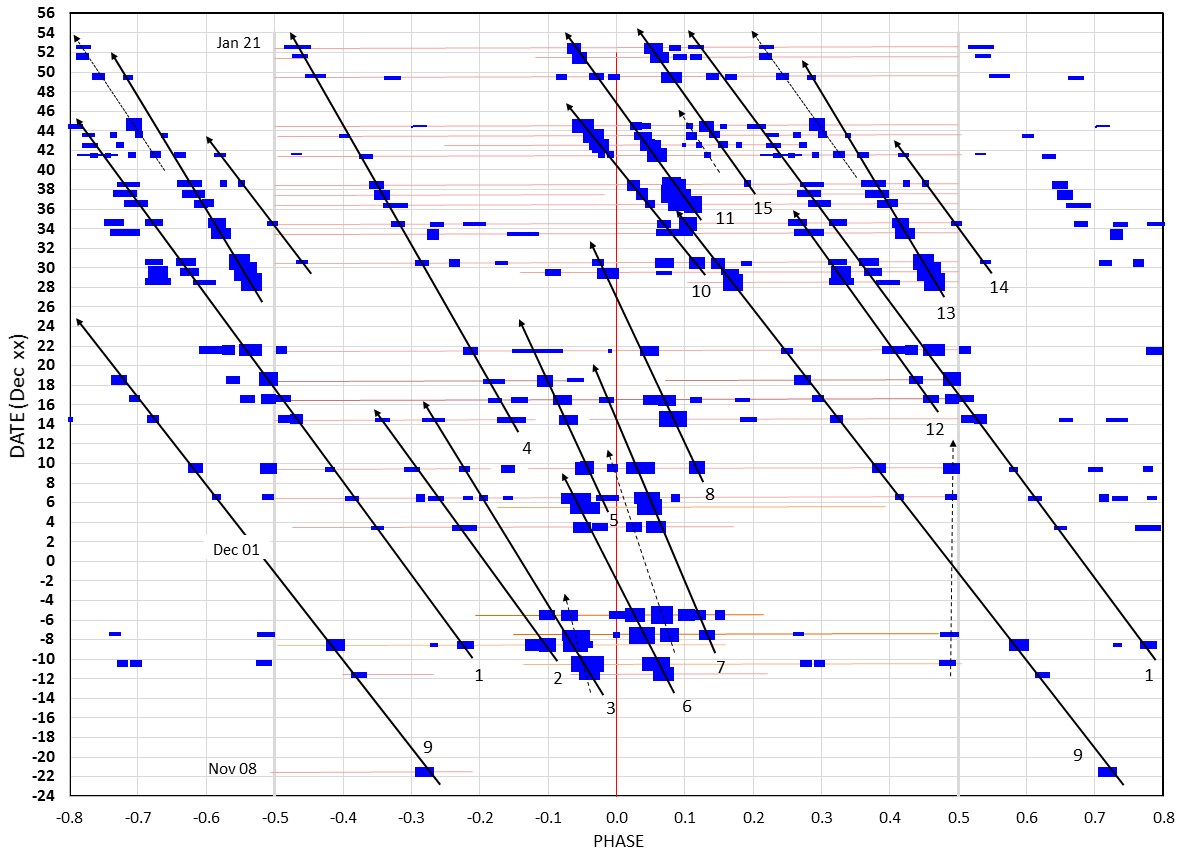
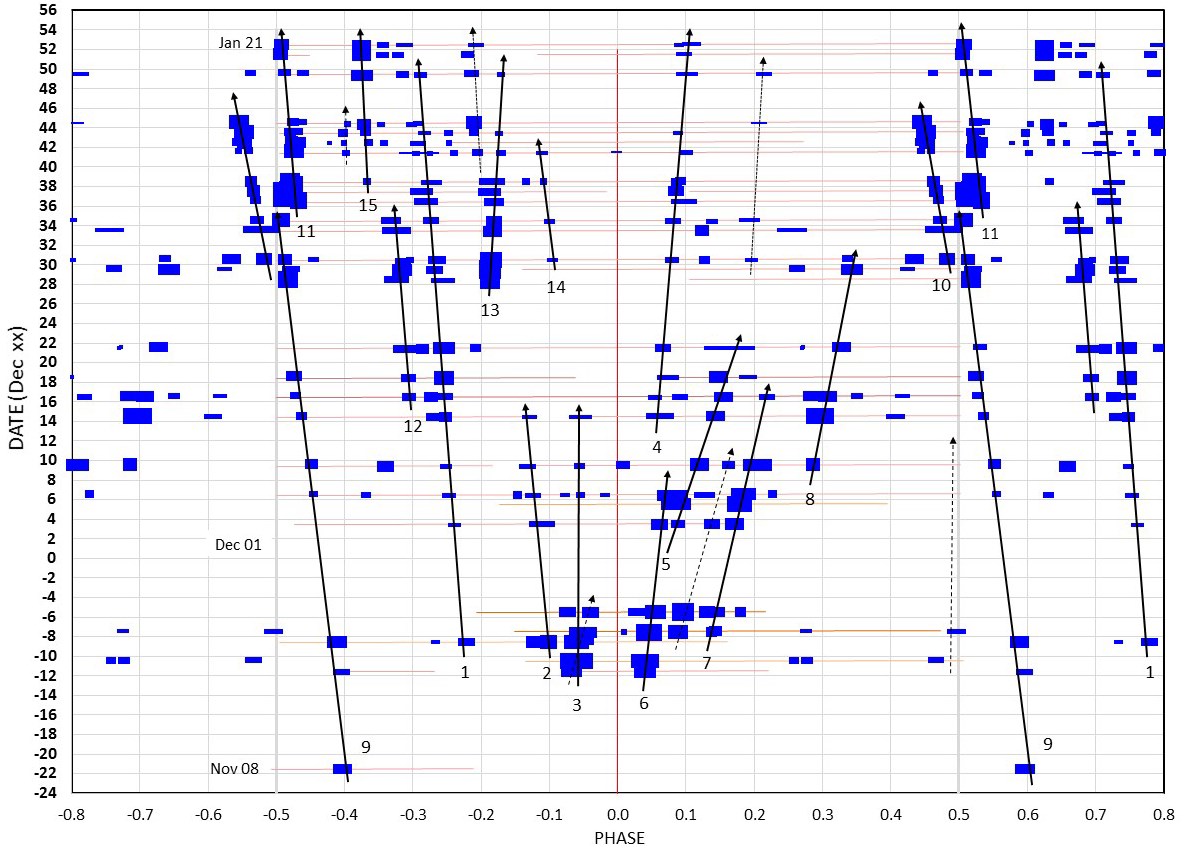

2016.01.21 Summary & Observer LCs
On this date Kaye & Gary obtained data.

Only Benni observed on
this date.

2016.01.18 Summary & Observer LCs
On this date Kaye & Gary obtained data.



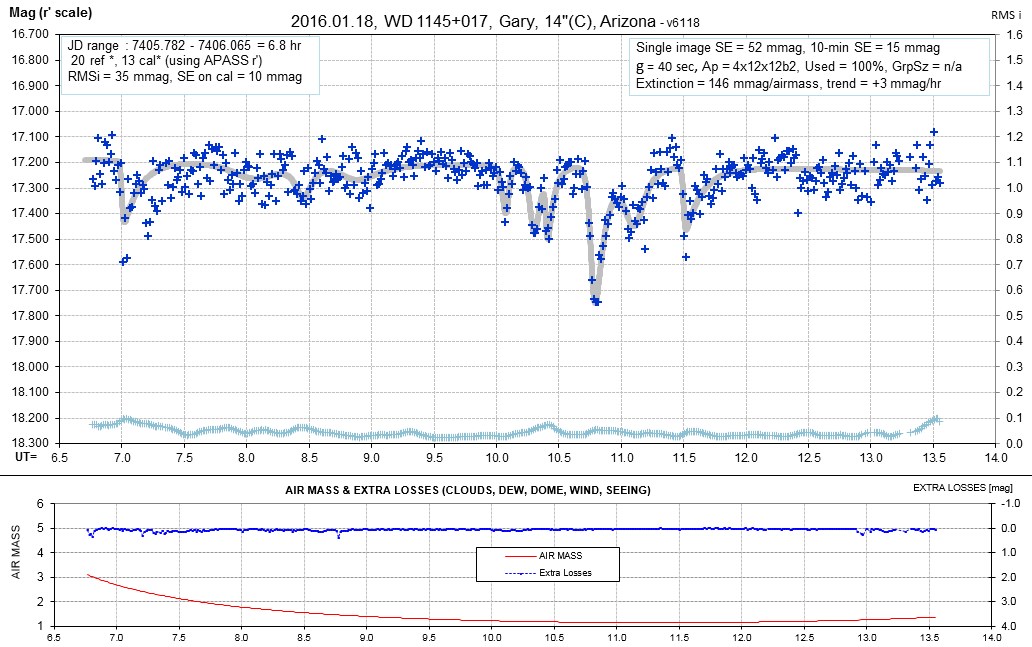
On this date Kaye
& Foote obtained data.



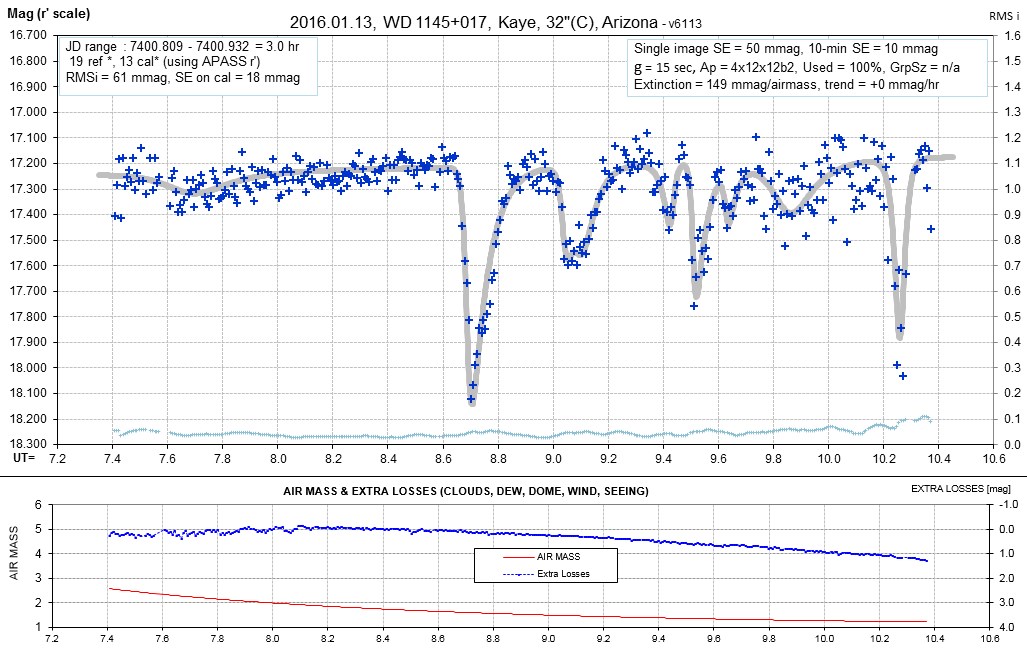

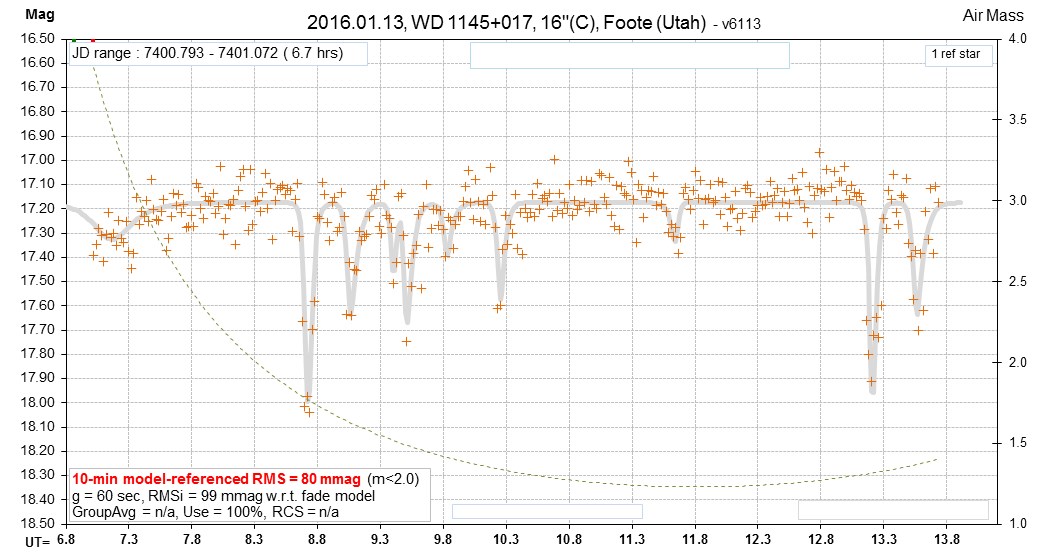
2016.01.12 Summary & Observer LCs
On this date Gary, Kaye, Foote & Benni obtained data.



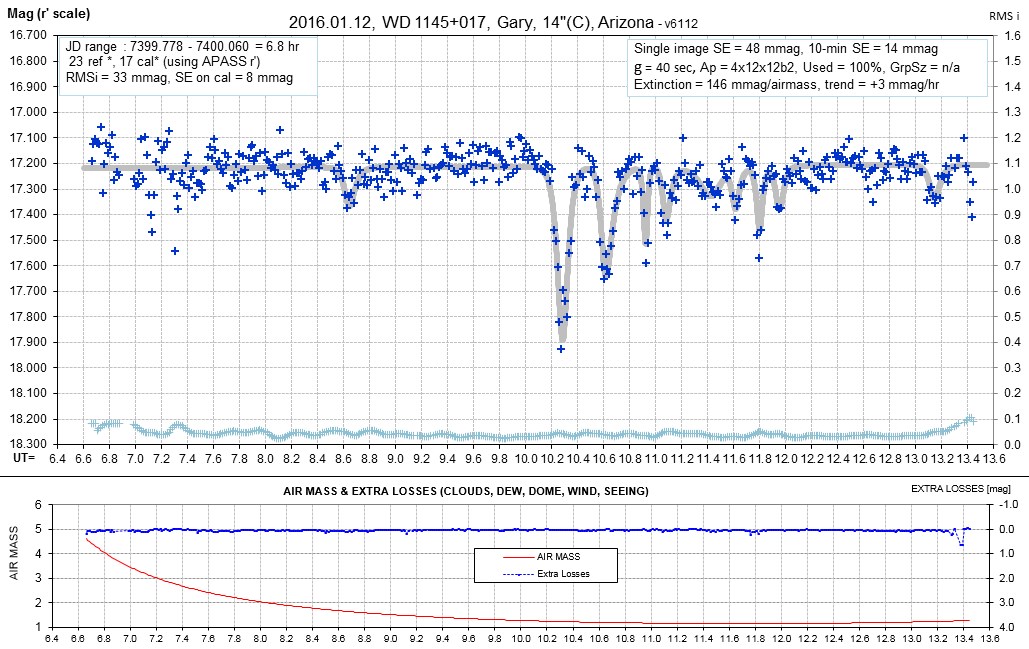
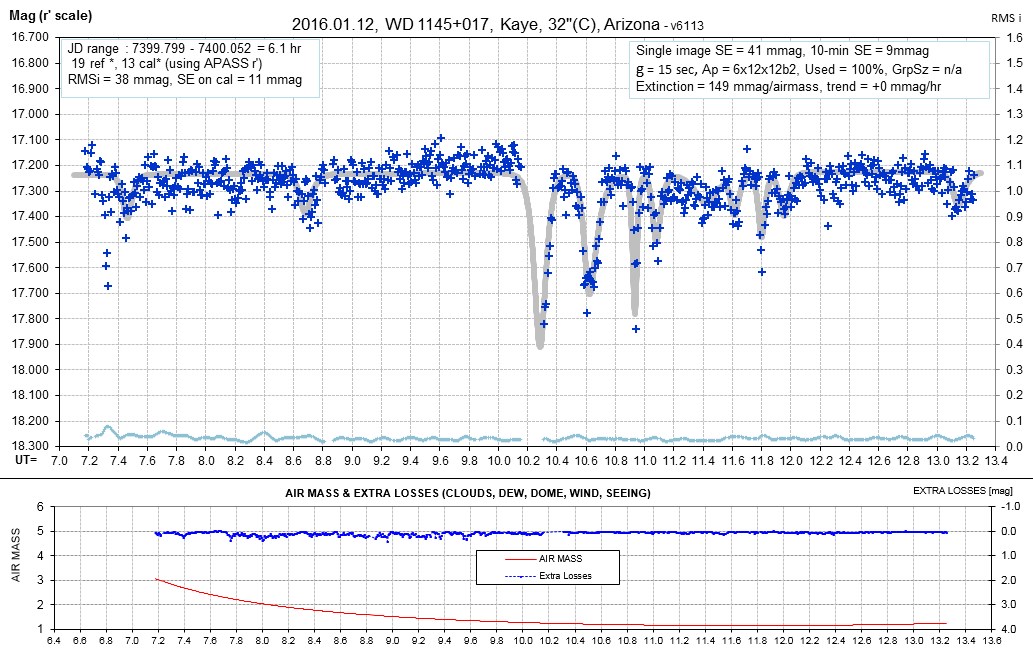
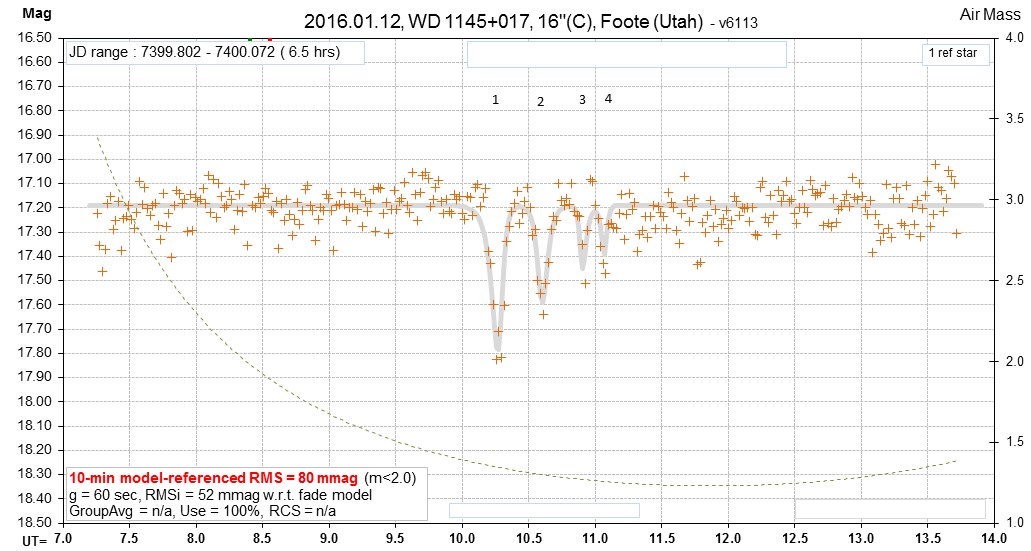
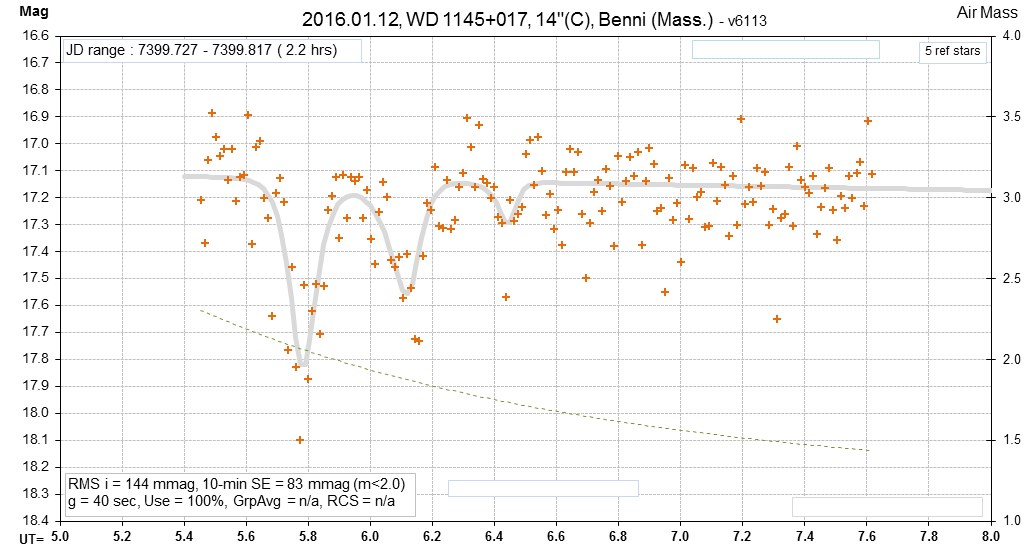
2016.01.11 Summary & Observer LCs

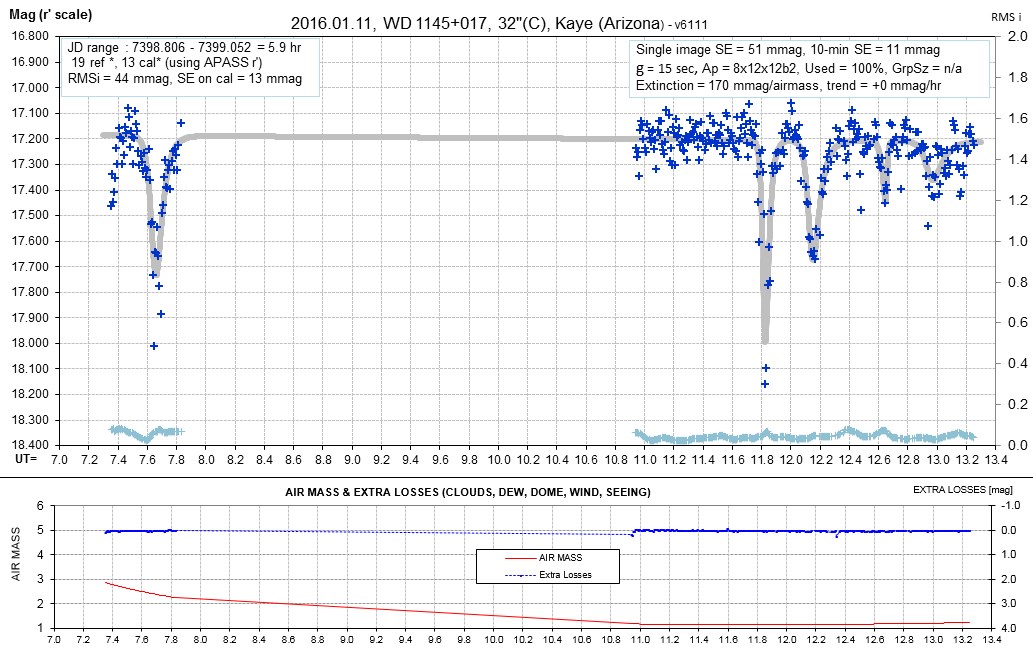
2016.01.10 Summary & Observer LCs
On this date Kaye and Gary obtained data.
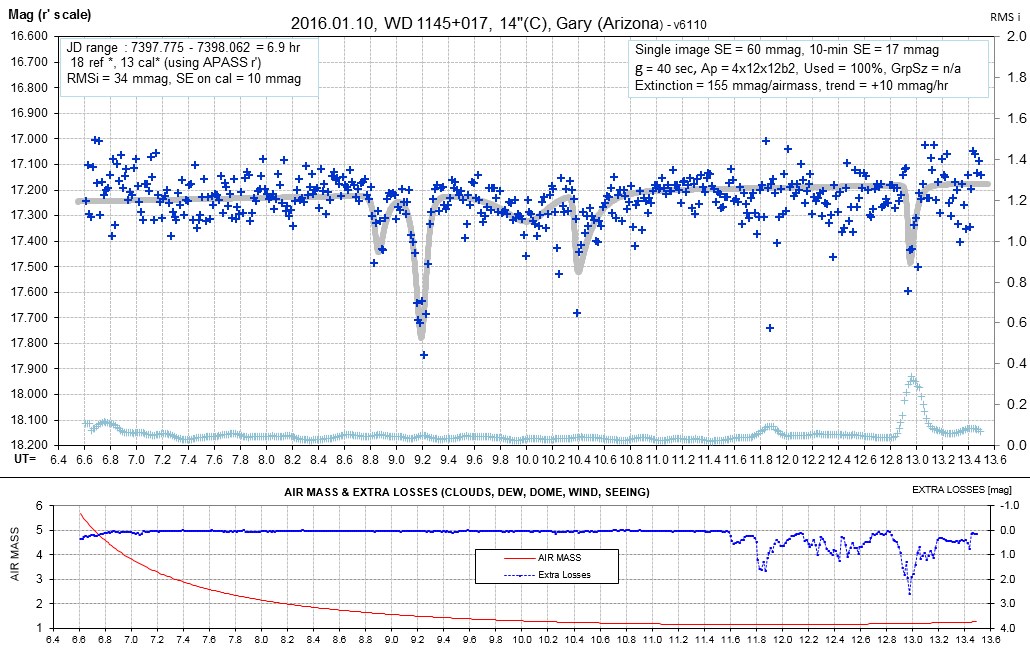


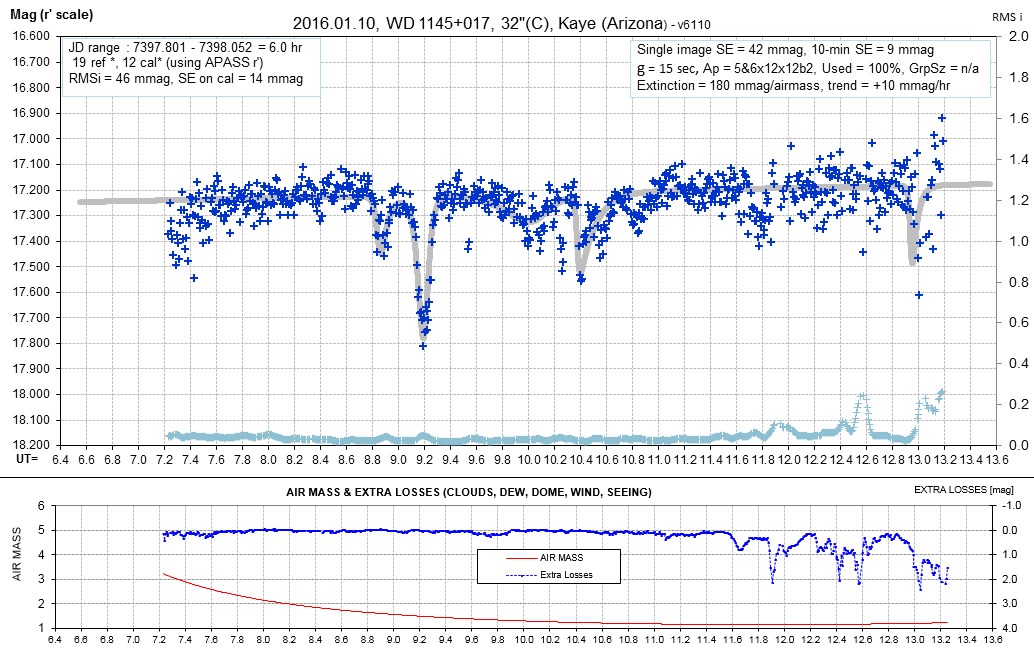

2016.01.07 Summary & Observer LCs
On this date only Paul Benni obtained data.
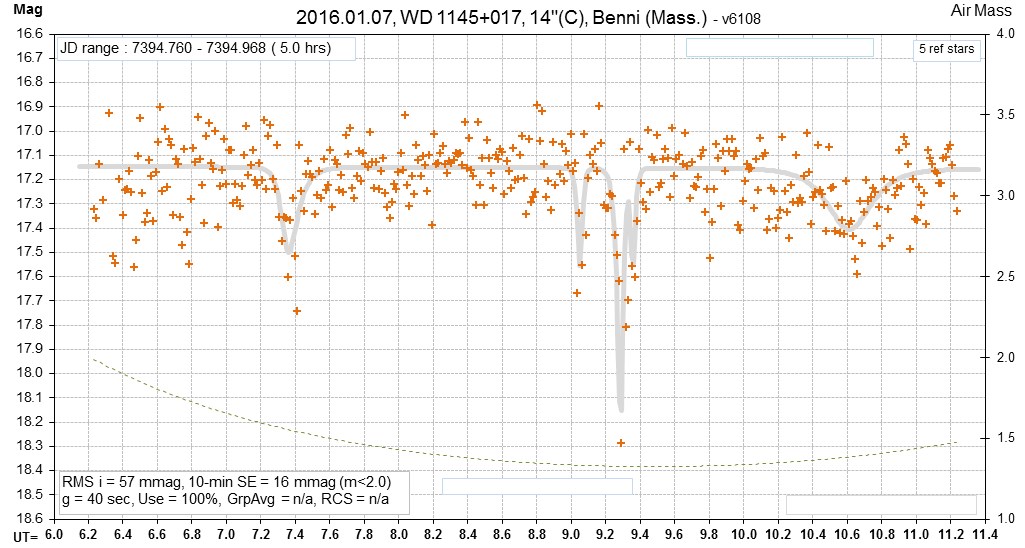

2016.01.06 Summary & Observer LCs
On this date only Paul Benni obtained data.
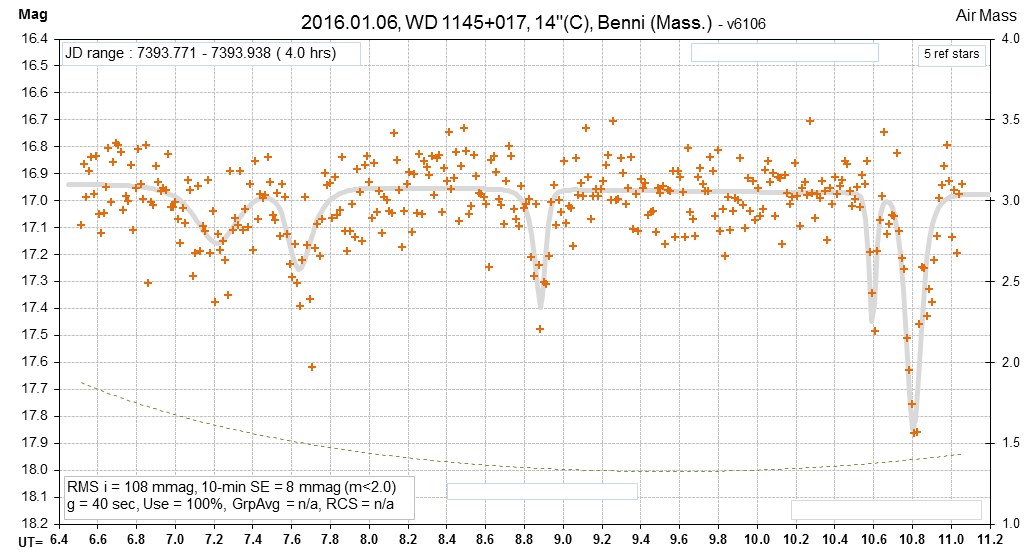

2016.01.05 Summary & Observer LCs

2016.01.03 Summary & Observer LCs

2016.01.02 Summary & Observer LCs

2015.12.30 Summary & Observer LCs
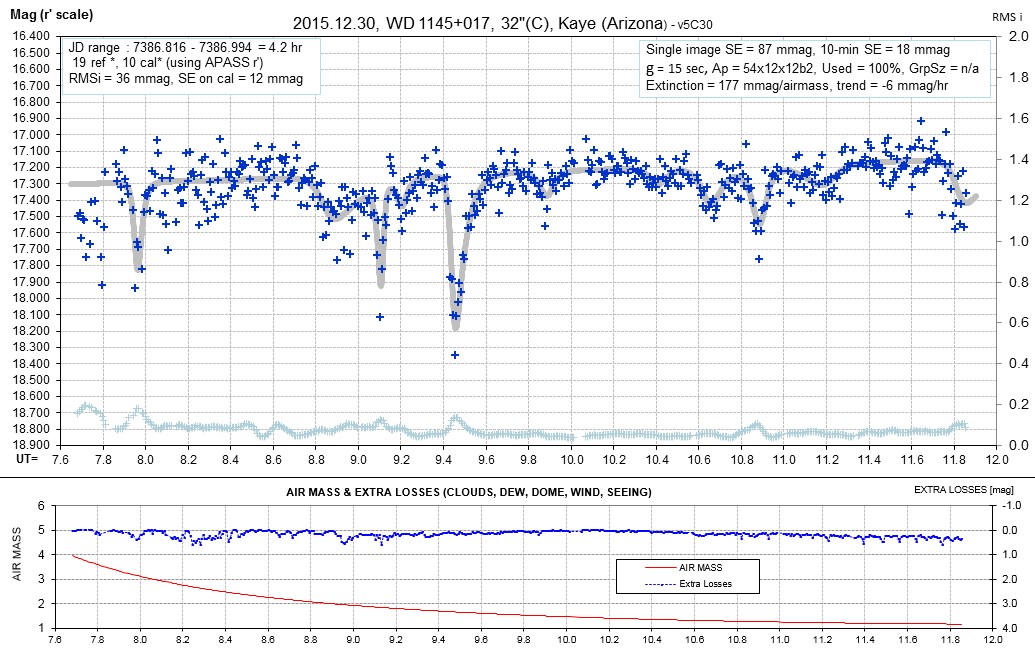
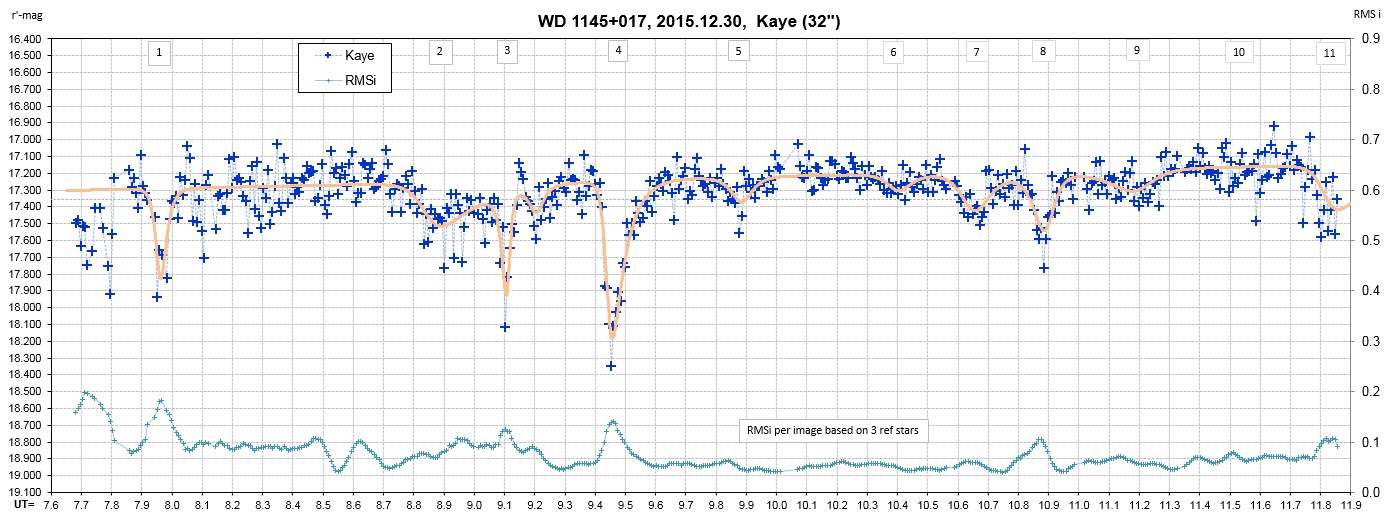


An alternate interpretation, phased with the A-period.
2015.12.29 Summary & Observer LCs
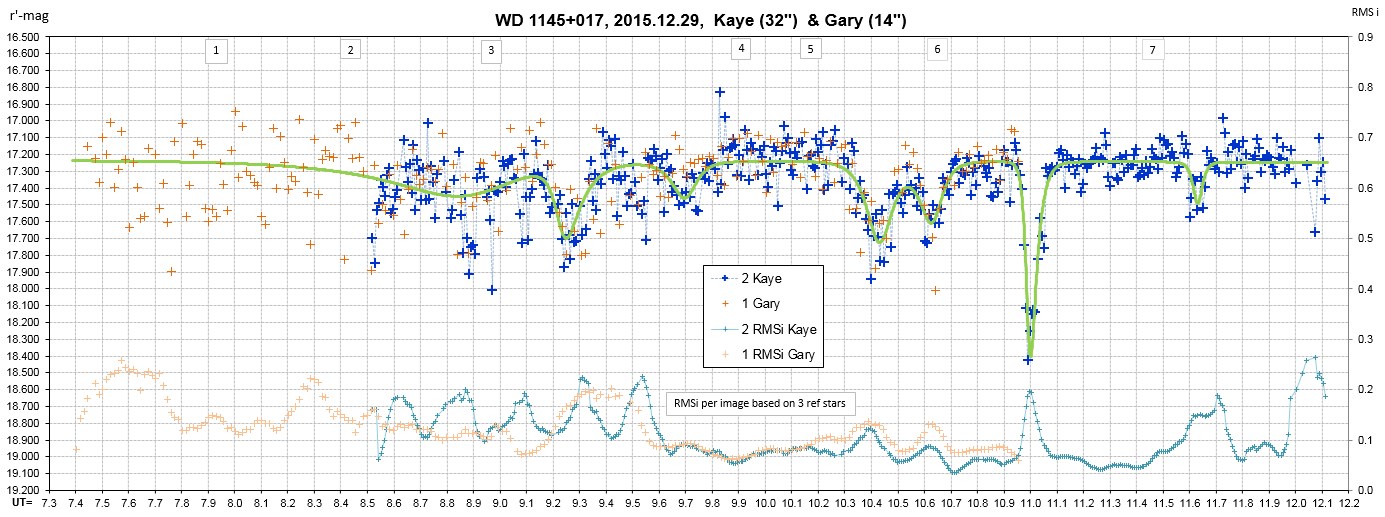
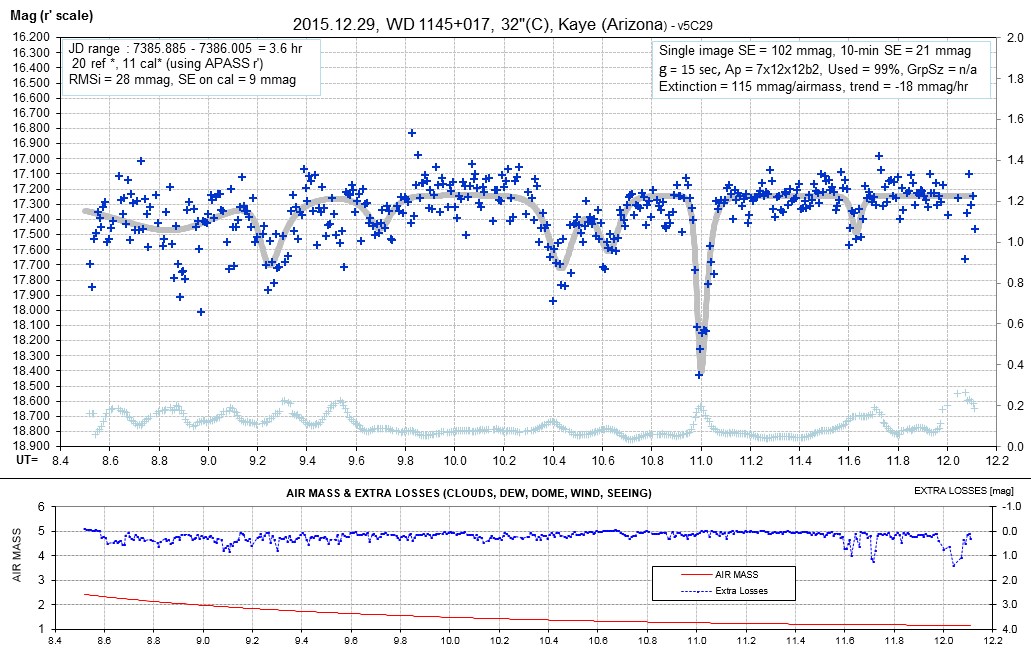
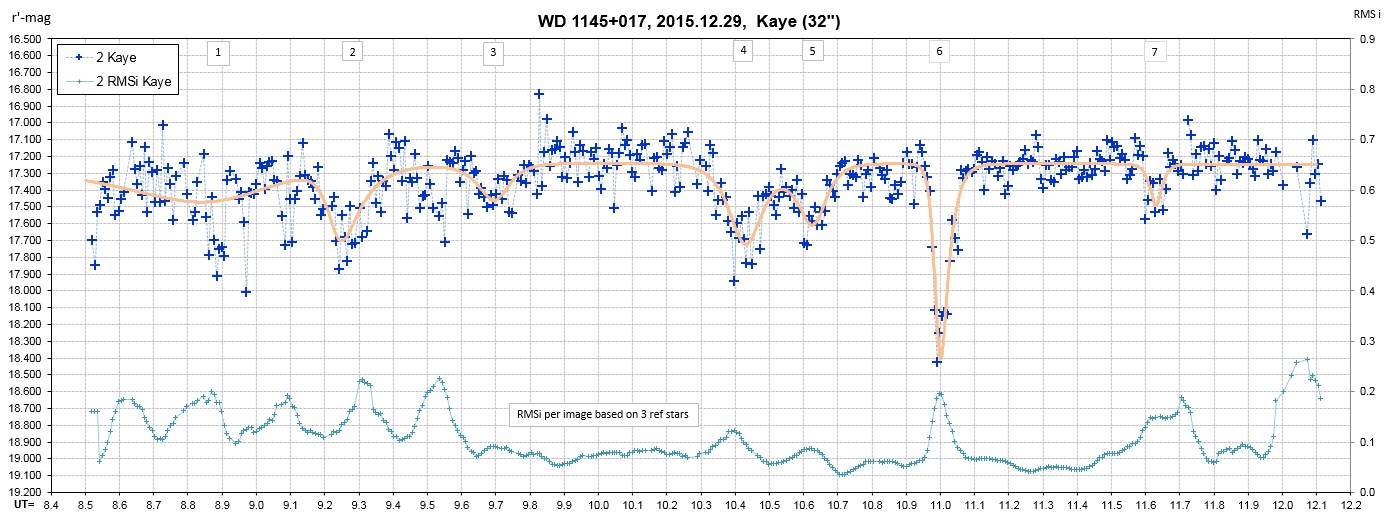
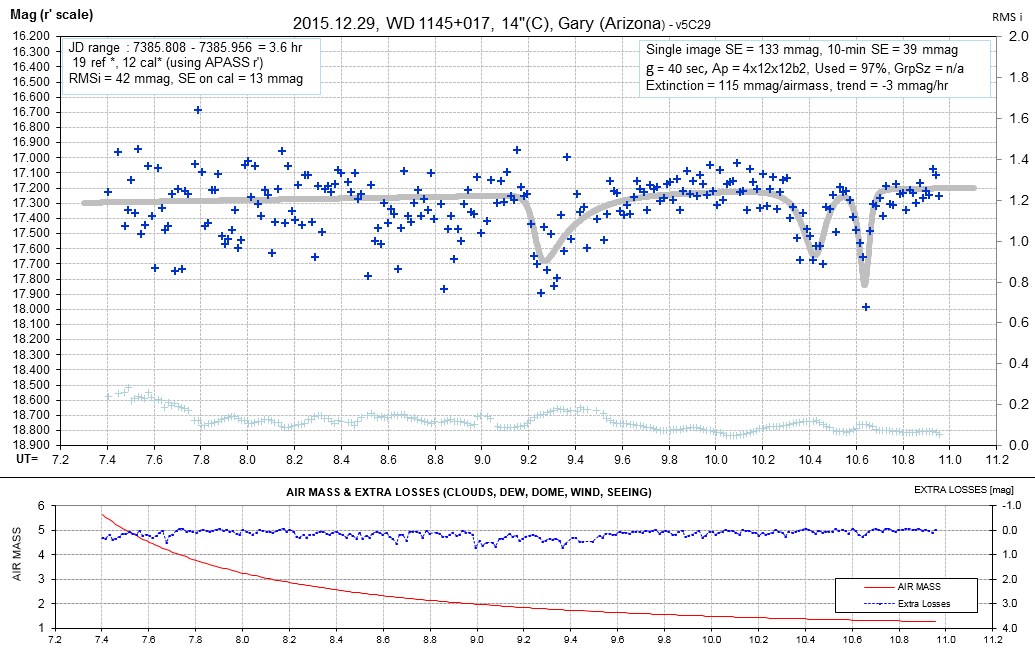
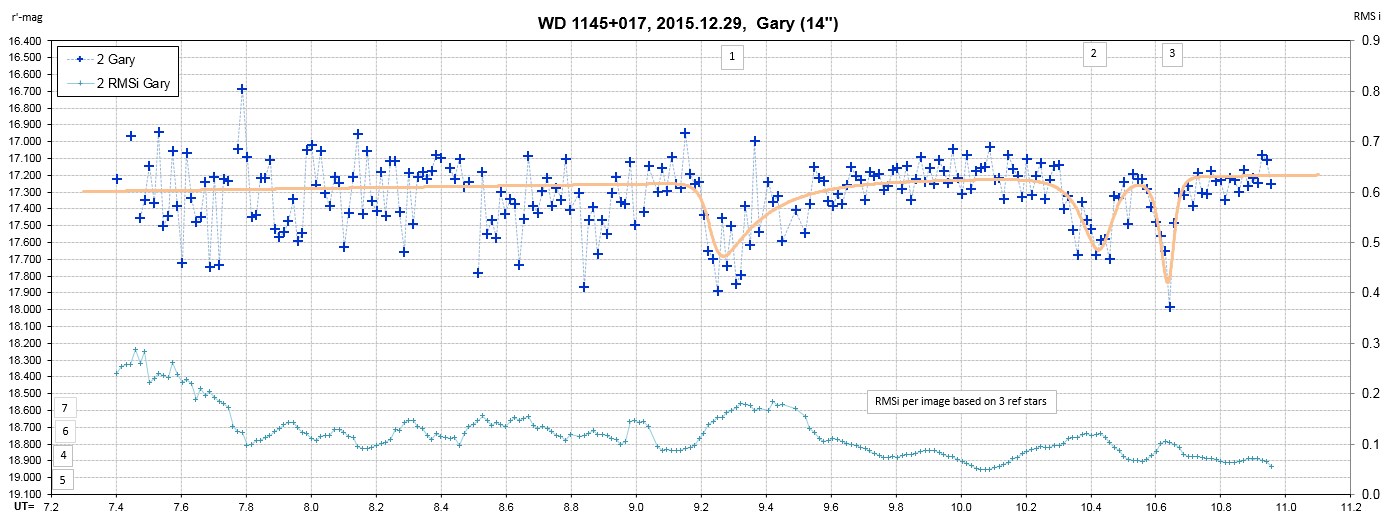

2015.12.28 Summary & Observer LCs
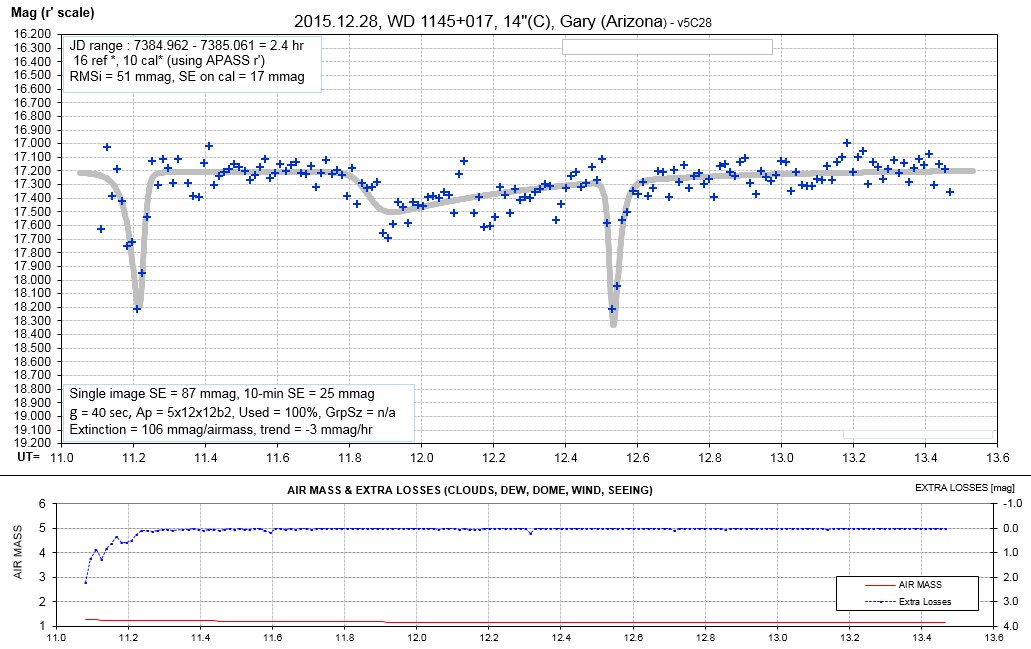
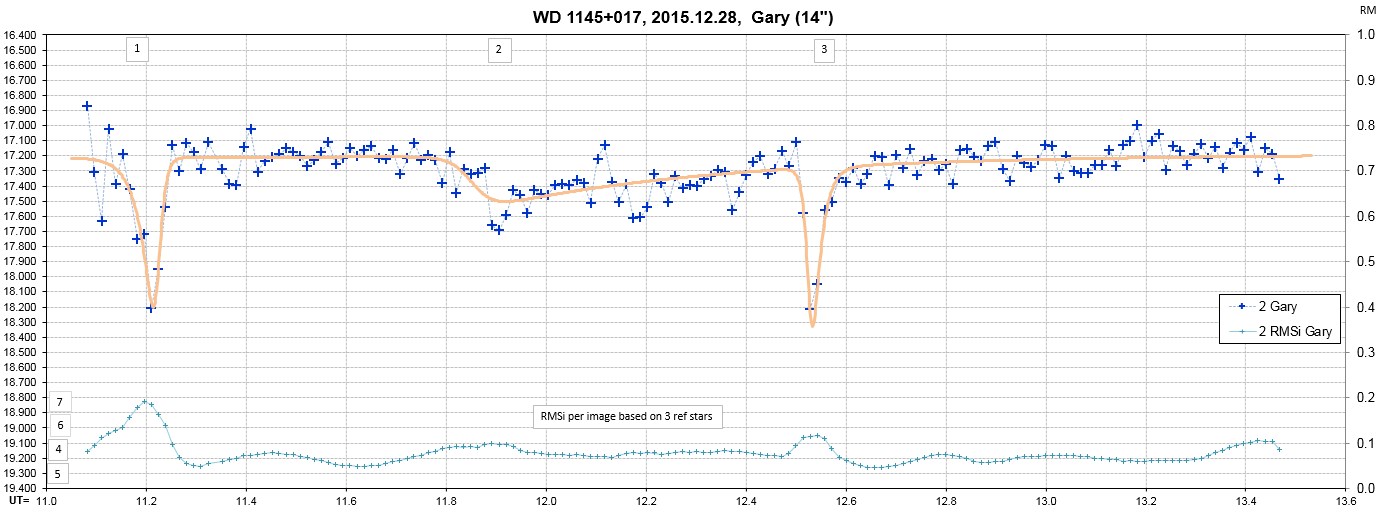


2015.12.21 Summary & Observer LCs
Tom Kaye and I obtained a full orbit's worth of data.
Here's an overlap of our data:


Comparing a phase-folded version of this data with the Dec 16
fade model is shown here:

I want to comment on a few events. Today's #4 might be the Dec 16
#2 (11.35 UT'). Most fade events were moving left at ~ 4 min/day,
so in 5 days the movement should be 0.33 hr. The Dec 16 #2 event
should now be at 11.00; it's at 11.05, which is close. Today's #7
might be the Dec 16 #5, phase shifted to an earlier time by only 5
minutes. Today's #9 & #10 might be associated with Dec 16 #8
(12.32 UT'). The shift between them is ~10 minutes. I suppose one
could argue that today's #1 & #2 are a drifted version of Dec
16's #9 & #10 (14.06 & 14.21 UT').
Here are the individual LCs:
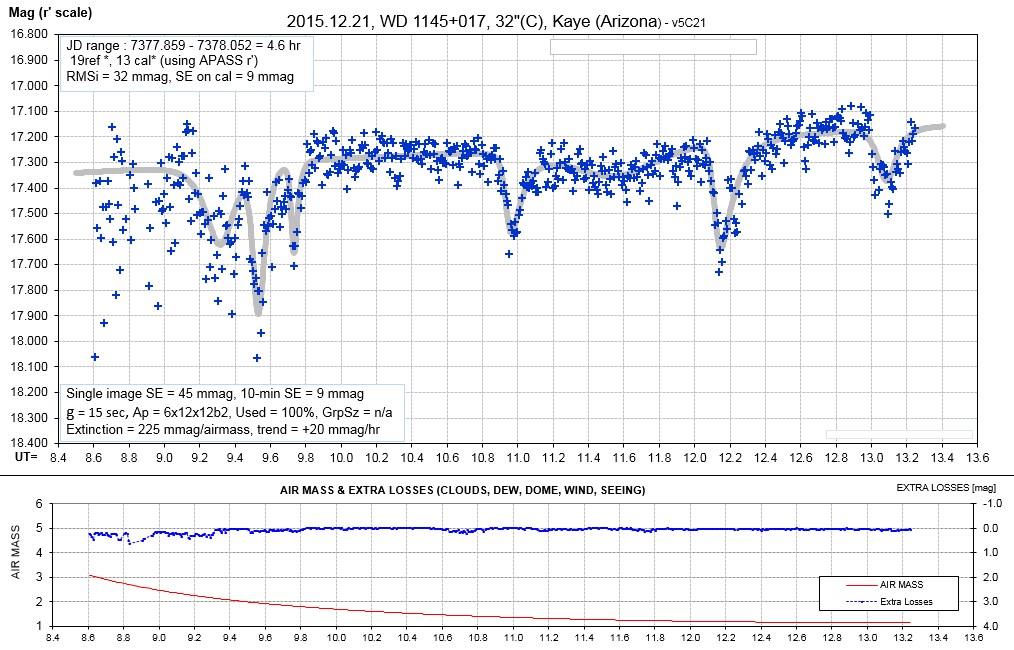
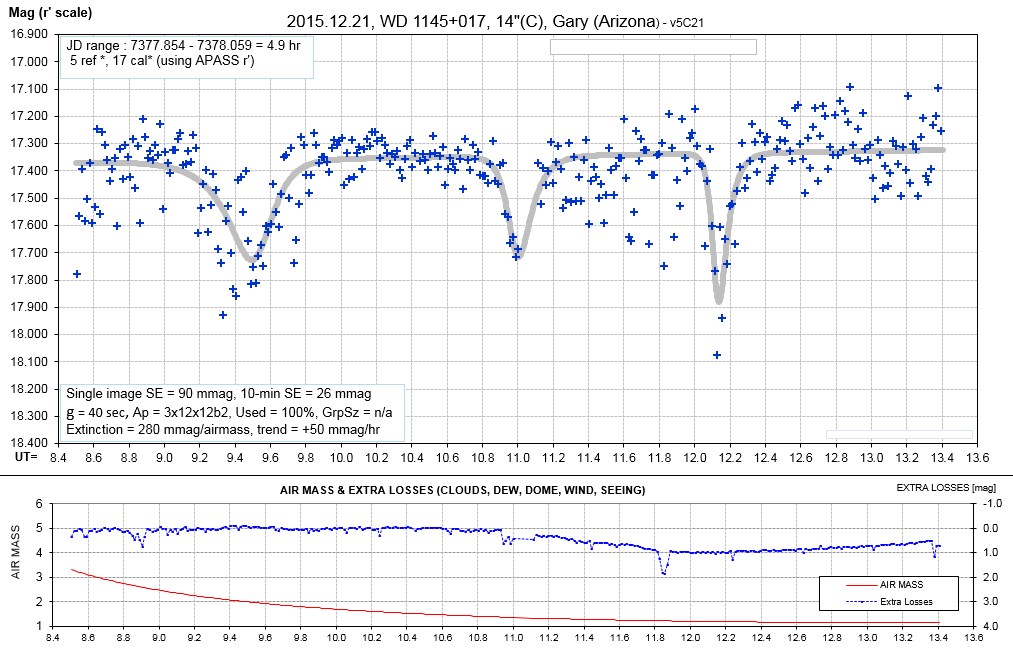
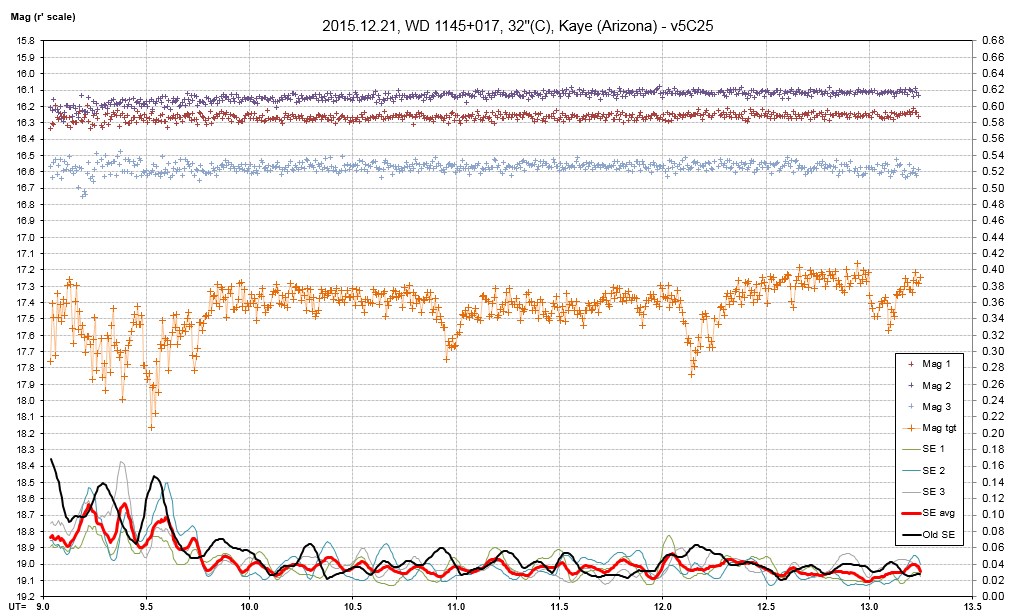
2015.12.20 Summary & Observer LCs
Only Paul Benni observed on this date (during cold, through holes
in the clouds). The LC by itself isn't impressive, but the true
value of this data becomes apparent when it is compared with LCs
from 2 & 4 days earlier.

I want to comment on each of the fades, starting from the left
end. Fades 1 & 2 are shallow, and Paul's noise was too great
to detect them. Fade 3 is a "sharp" one, and it has moved leftward
at the same rate suggested by the Dec 16/18 comparison. Depth and
width are similar. Clouds prevented measurement of fade 4. Fade 5
seems to be present still, without a phase shift. Fades 6 & 7
are too shallow for measurement. Fade 8 resembles fade 3 by being
sharp; although clouds interfered with getting the onset of this
fade, it does appear to be present in Paul's data, and possibly
shifted leftward by a small amount. Fade 9 is growing in width and
depth, and appears to be moving leftward slowly. The fade 10/11
pair are still present, and maybe growing deeper and continuing
their leftward phase shift.
Benni (11"):
Paul Benni observed in the cold through holes in the clouds, and
produced a LC that was unusually valuable in confirming fade phase
drift behavior. The LC by itself isn't impressive, but the true
value of this data becomes apparent when it is compared with LCs
from 2 & 4 days earlier (see above).
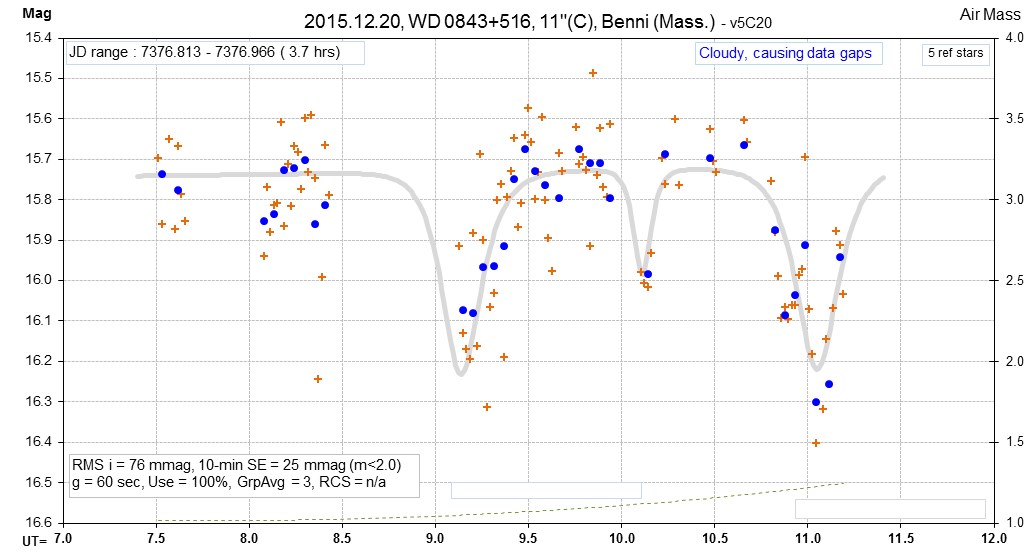

2015.12.18 Summary & Observer LCs


The Gary Dec 18 LC (40-second exposures) is
compared with the Gary/Kaye consensus LC for Dec 16 with the
fade model fit for Dec 16. The fade event numbers at the top
are for Dec 16 data. All times are UT', not UT.
Two sharp fades are present in the Dec 18 LC, at 11.6
& 13.3 UT'. Both have trailing tails and each goes from
the no-fade level to peak fade in 1 minute or less. Each
occurs ~ 6 minutes before counterpart sharp fades 2 days
earlier (fades #3 & #8). Thus, these two sharp fades
appear to be shifting to earlier times (i.e., smaller orbits).
At 14.05 UT' the Dec 18 broad fade might be associated with
fade #9 of 2 days earlier. A moderately sharp fade is present
at 14.3 UT' that might be associated with fade #10 & #11.
It is tempting to wonder if fade #11 shifted to the location
of #10, causing it to appear deeper.

Gary (14")
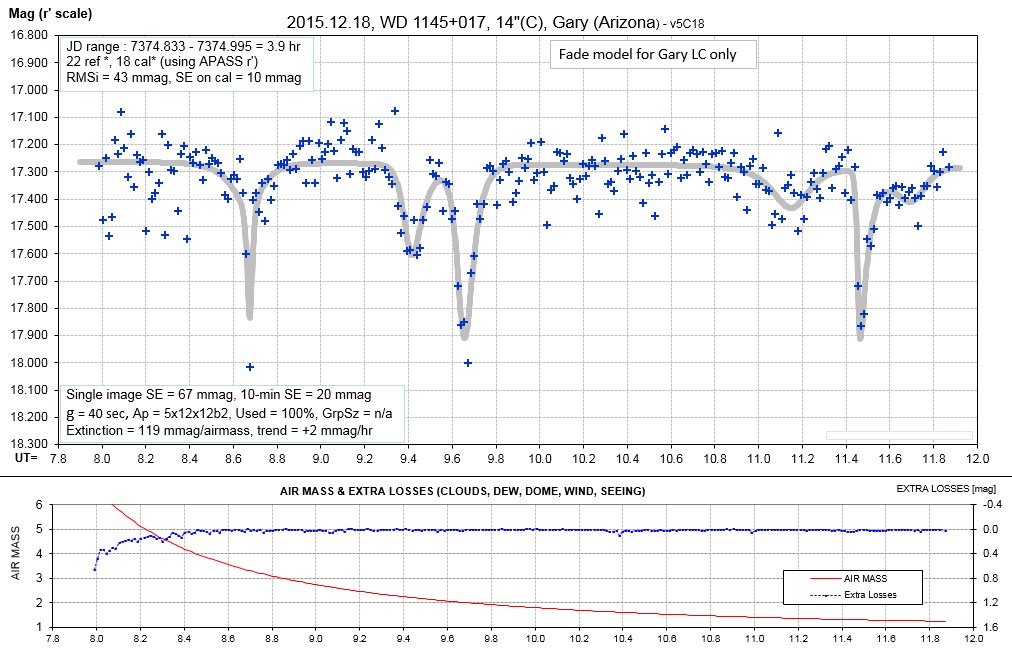

Kaye (JBO 32")
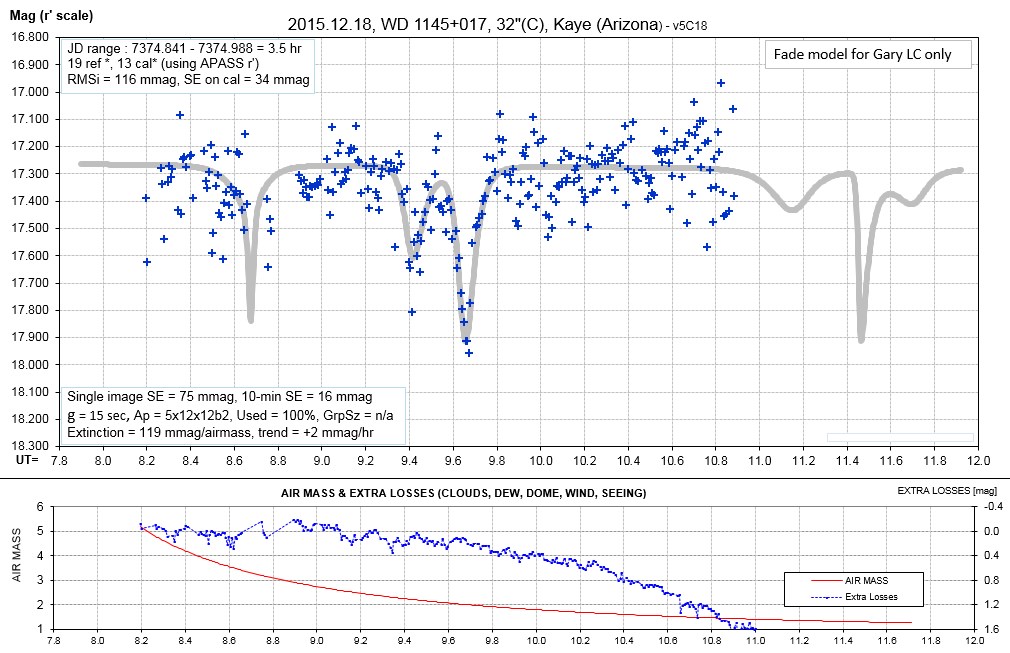
2015.12.16 Summary & Observer LCs
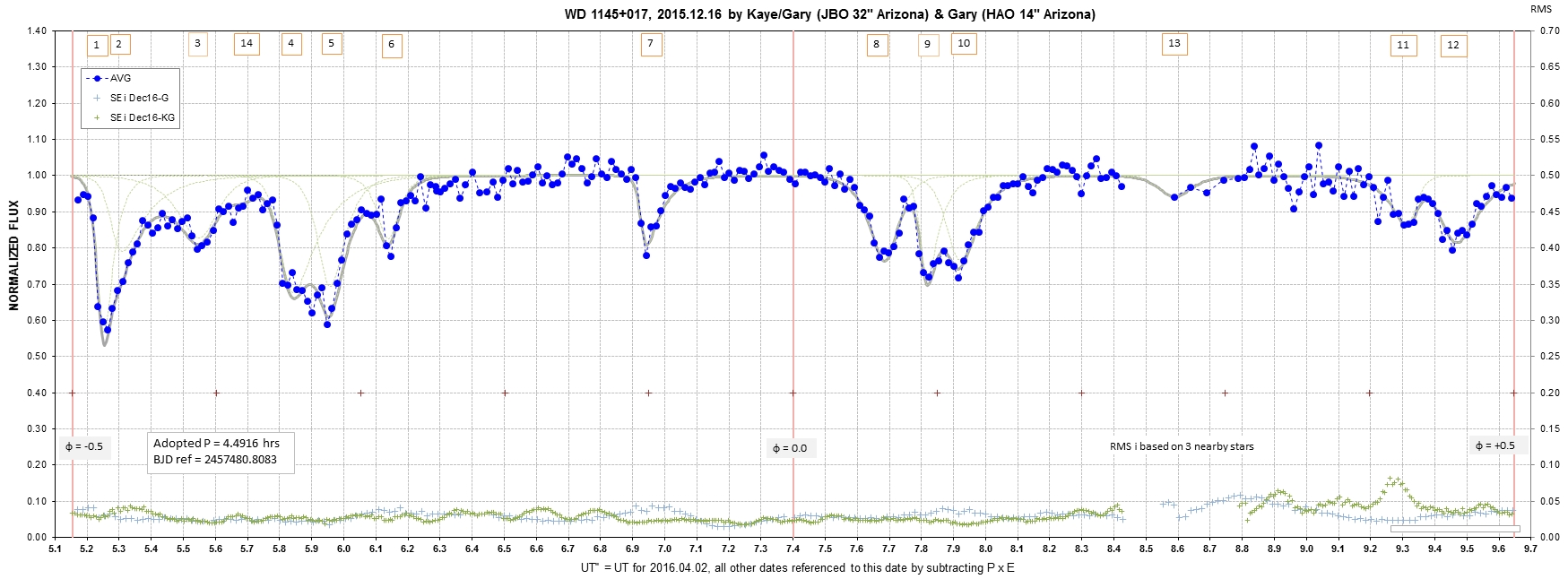
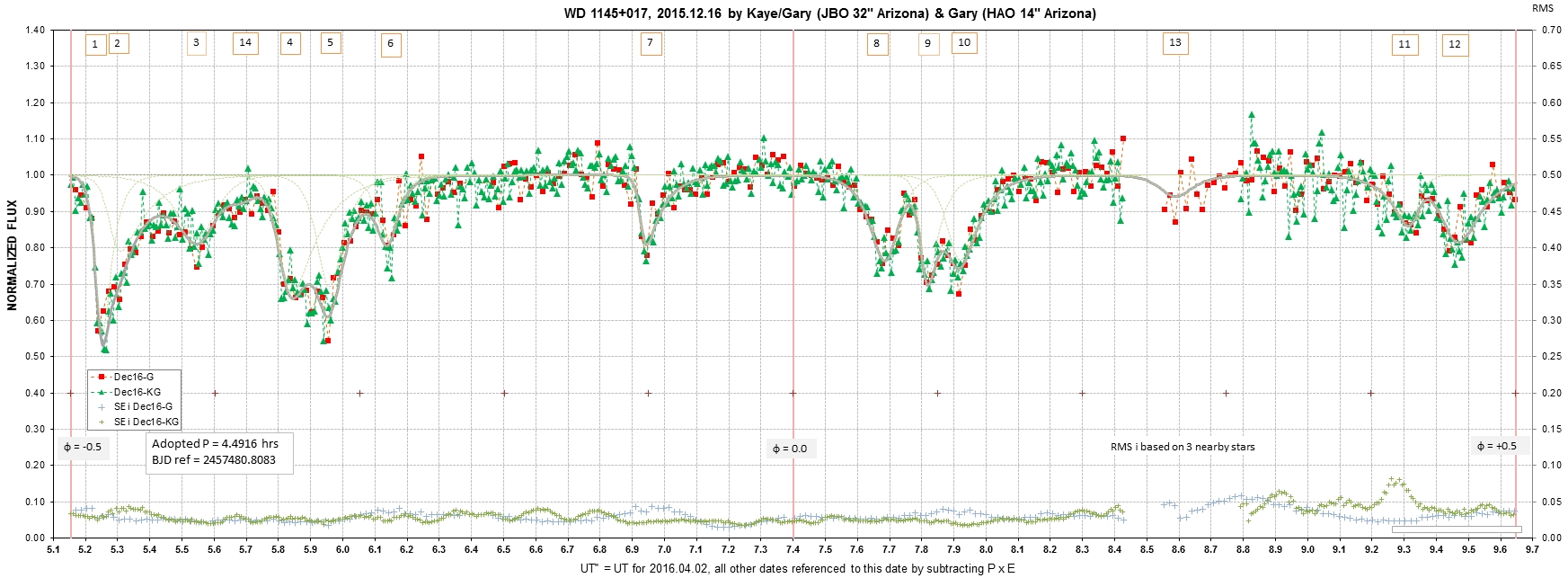
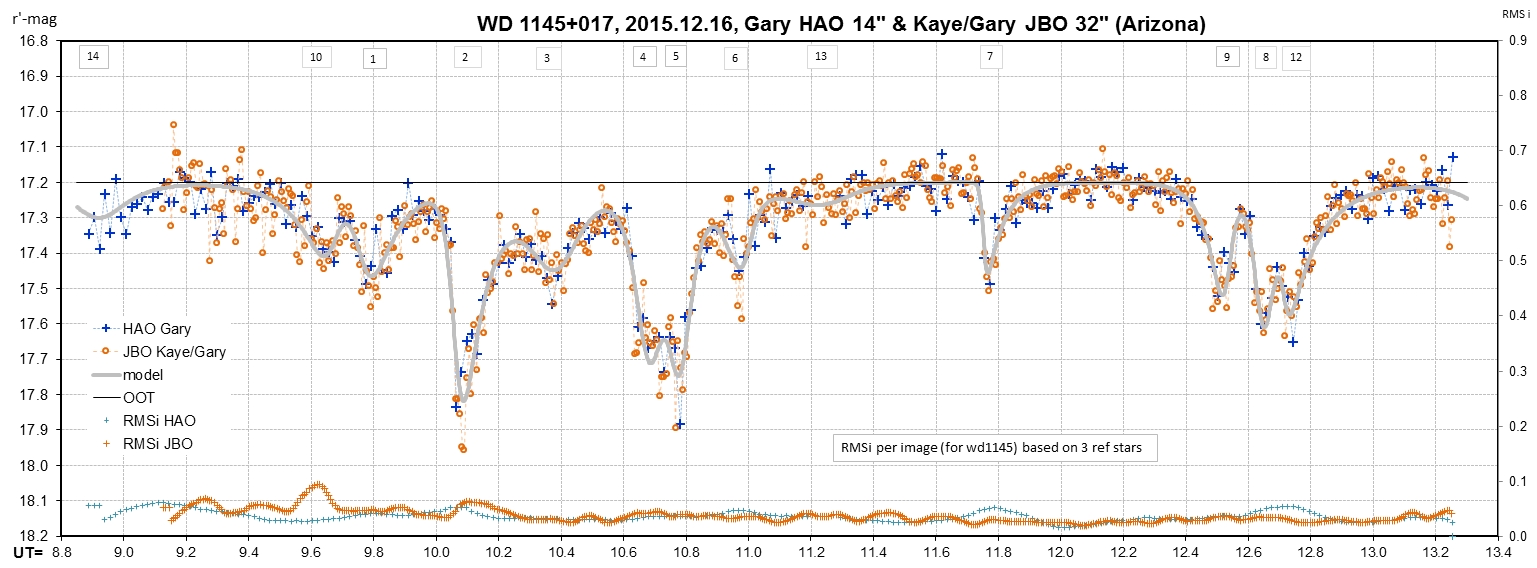
Gary (14")
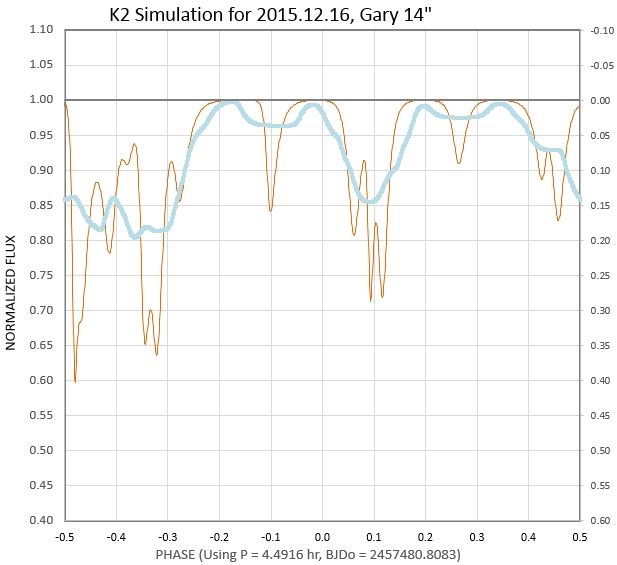
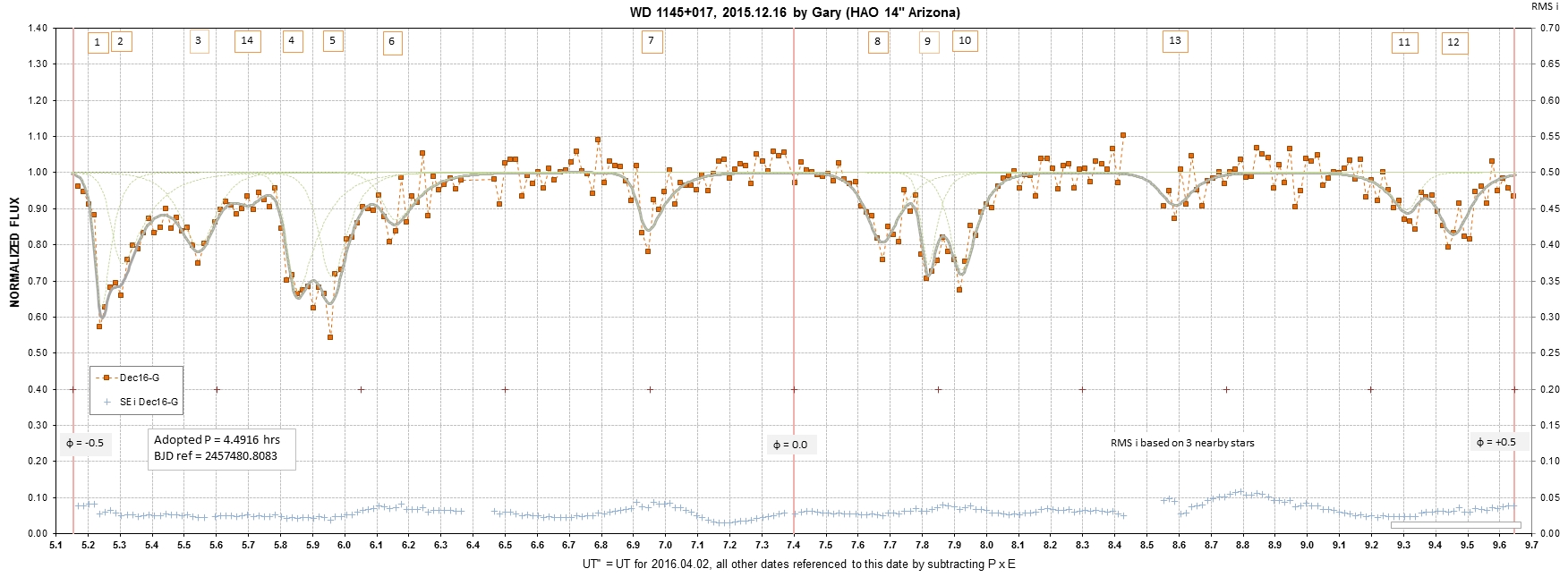
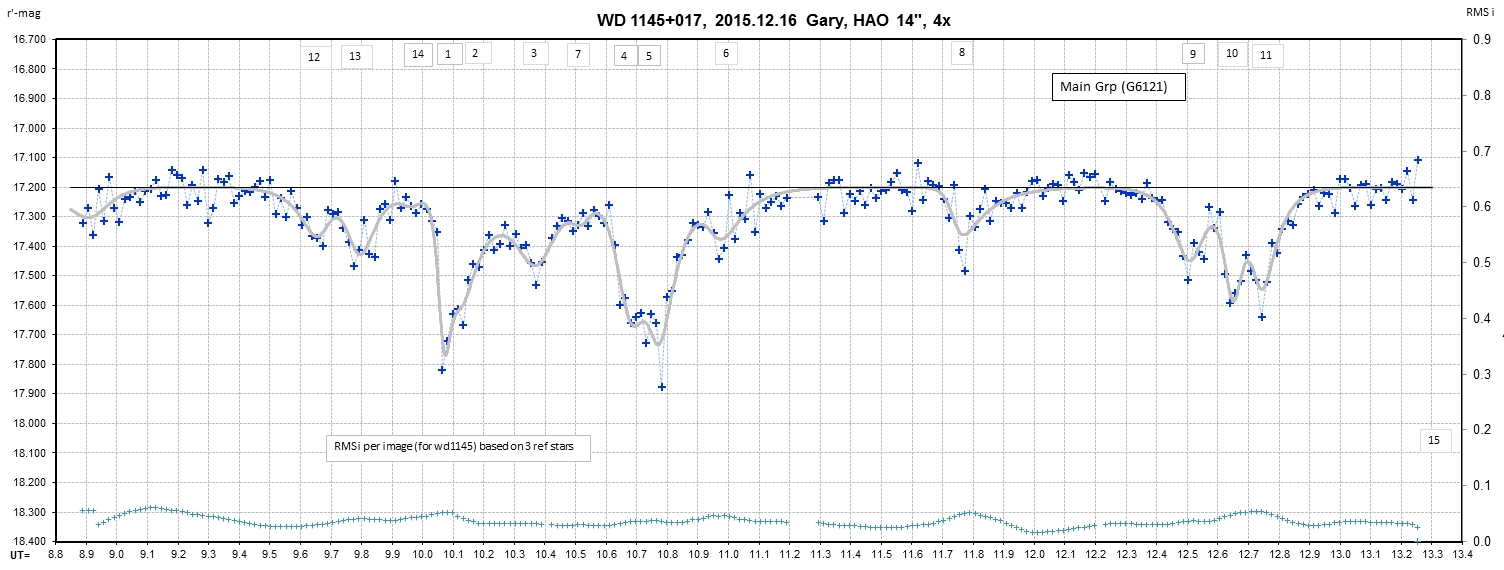
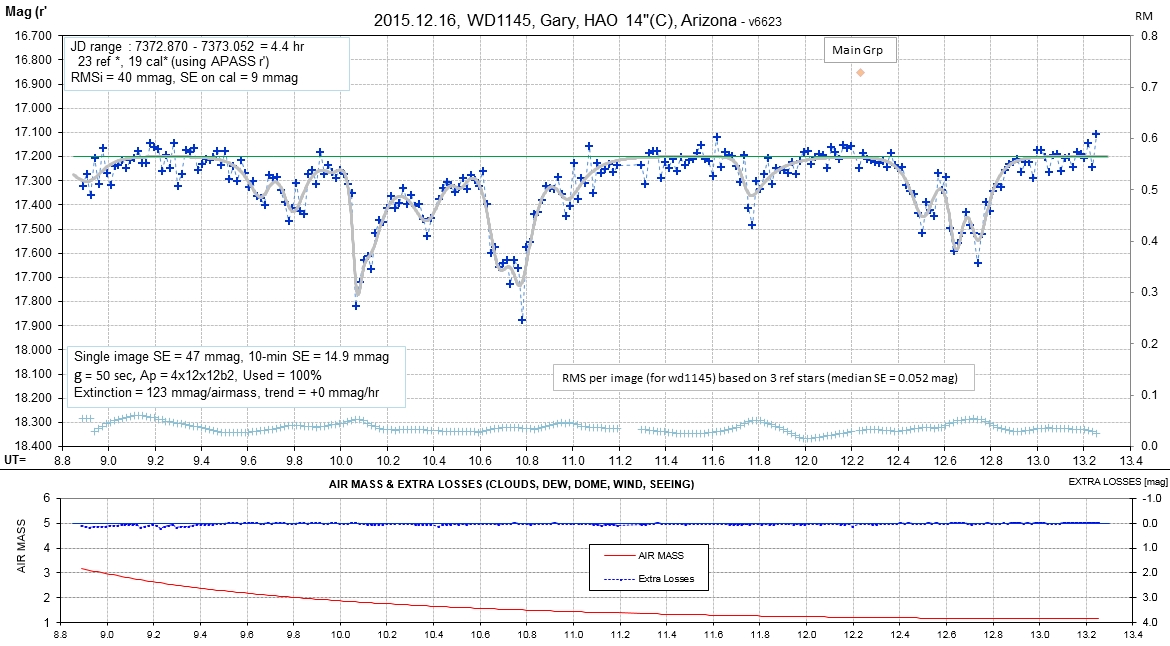
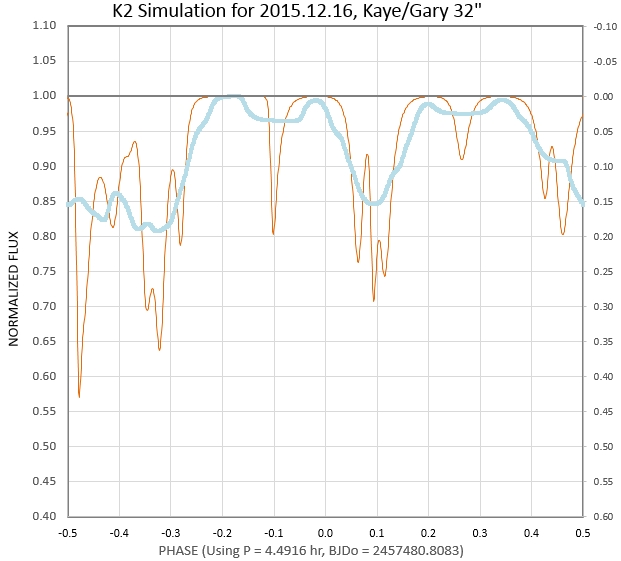
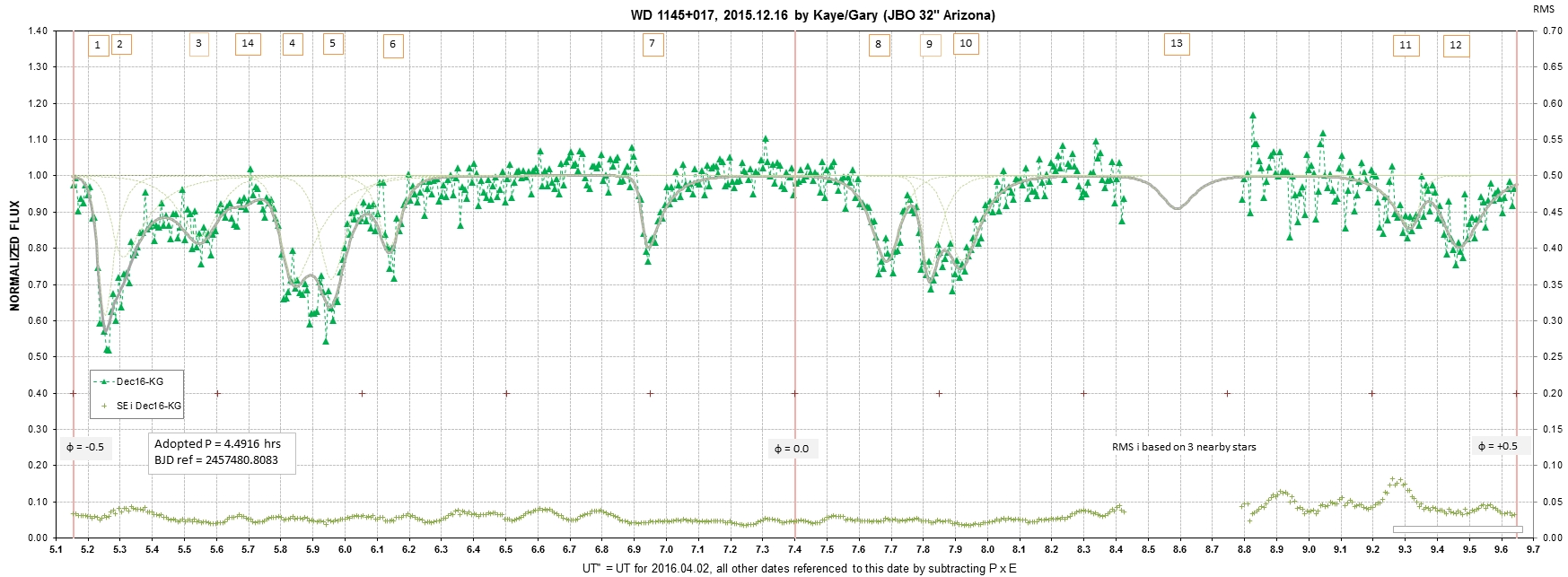



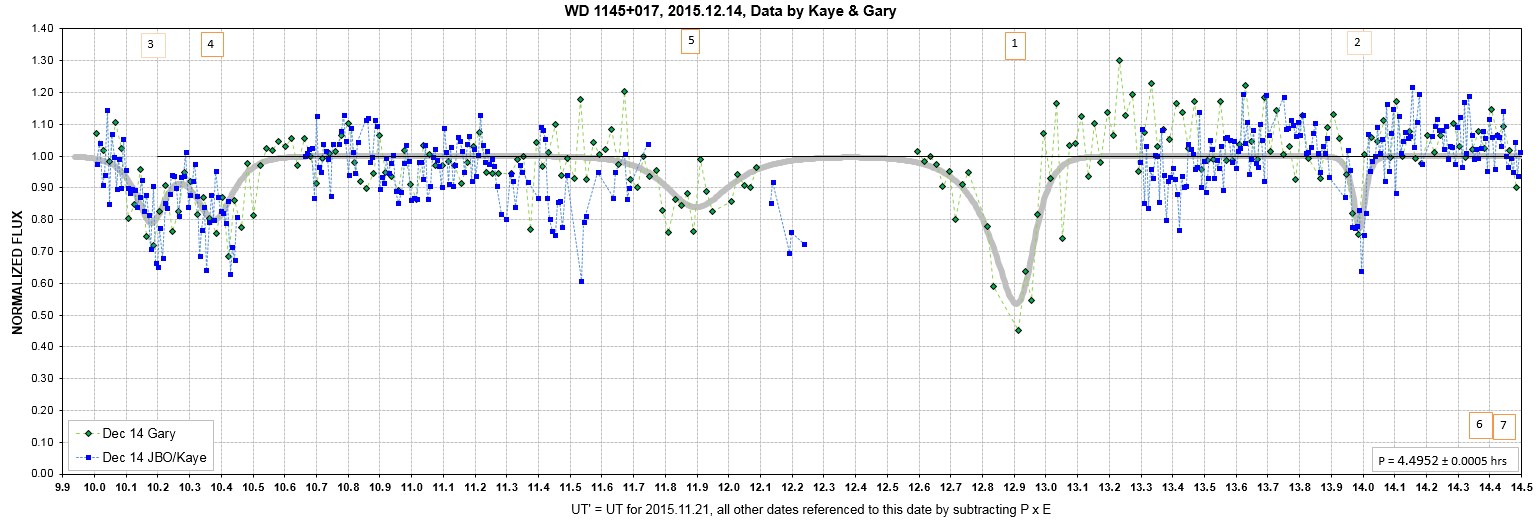
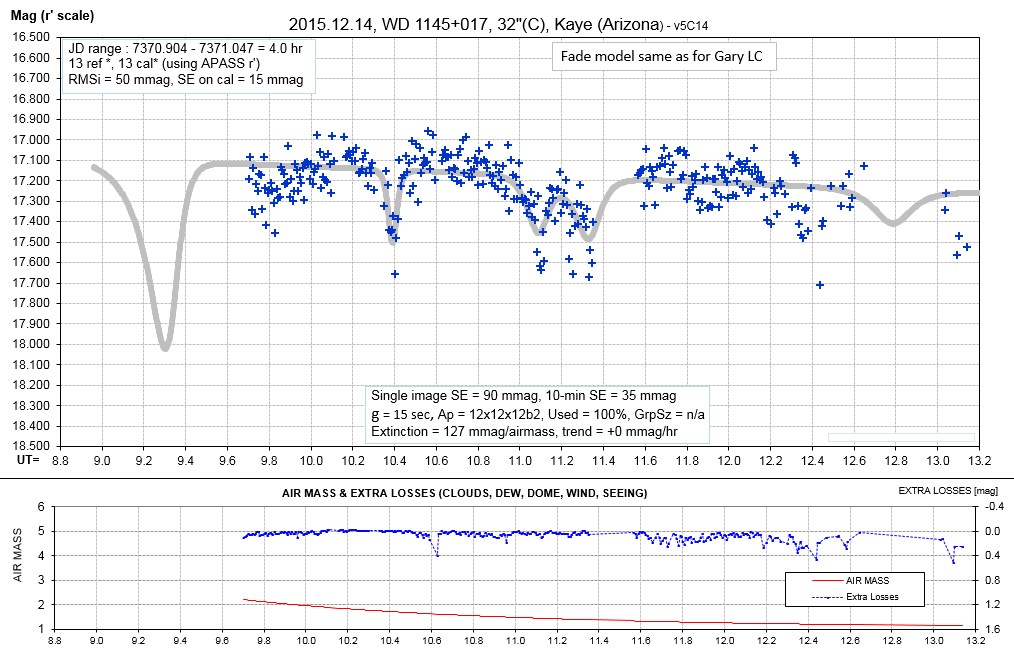
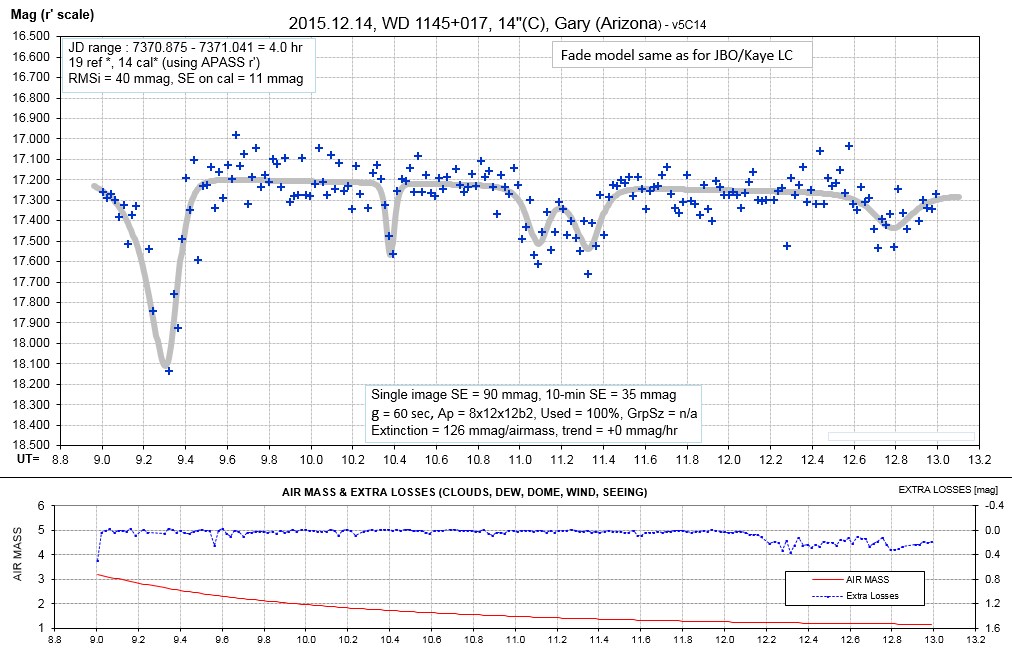

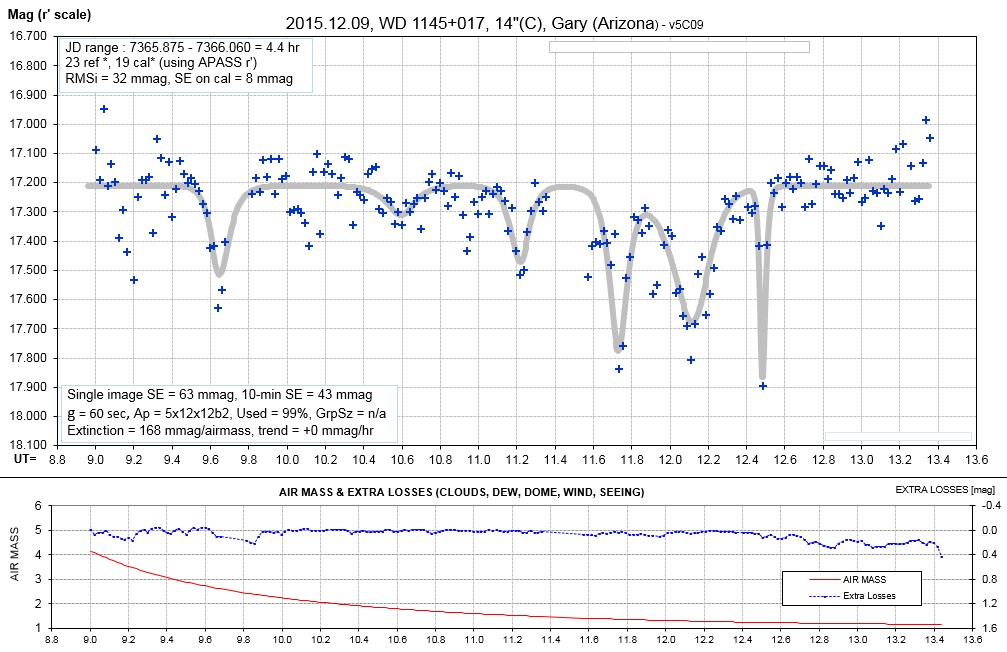
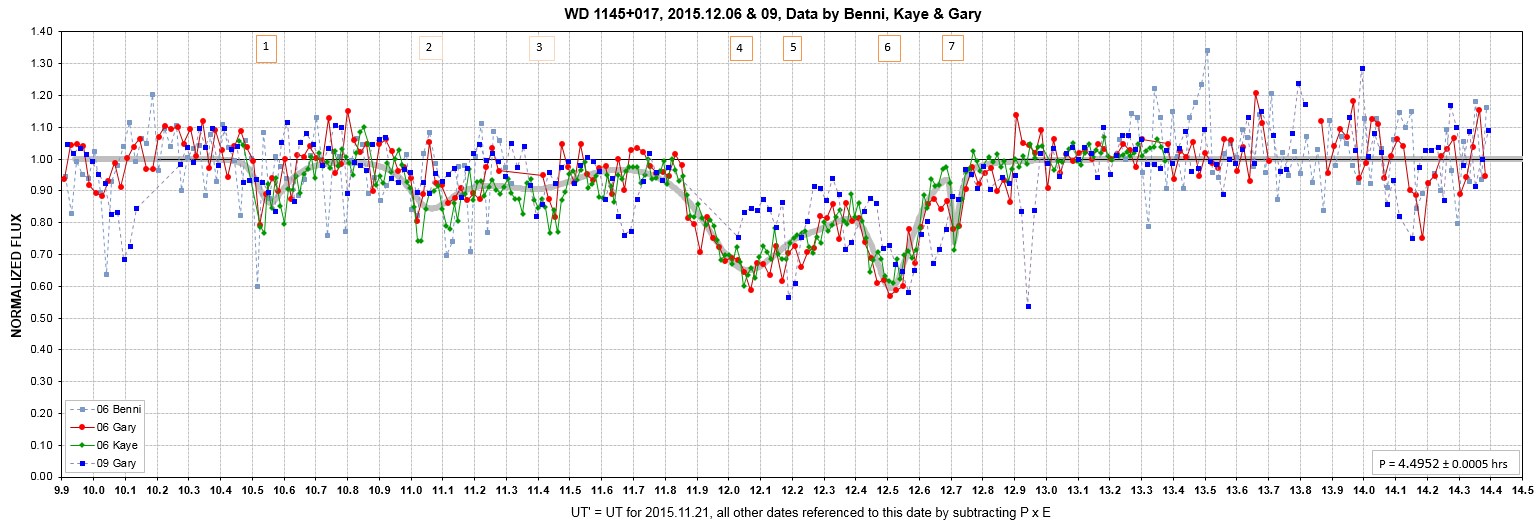
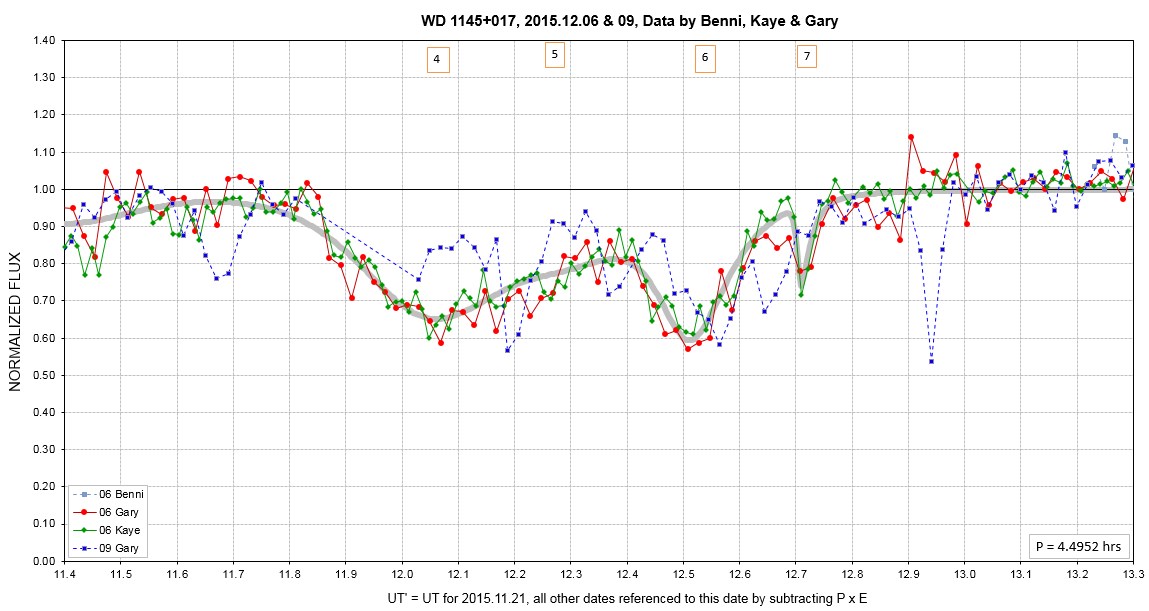


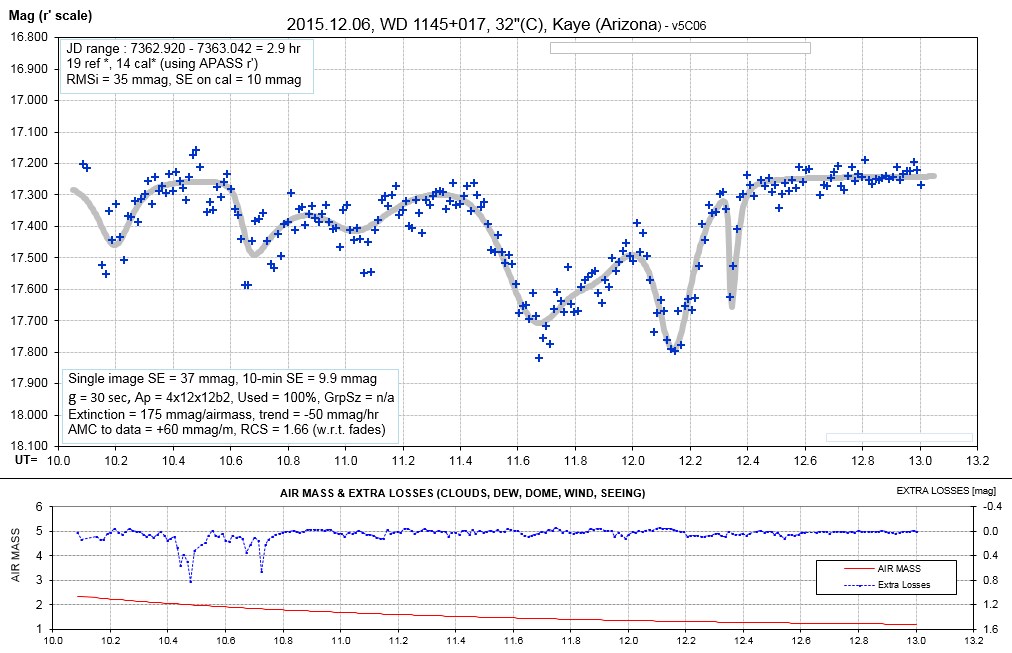
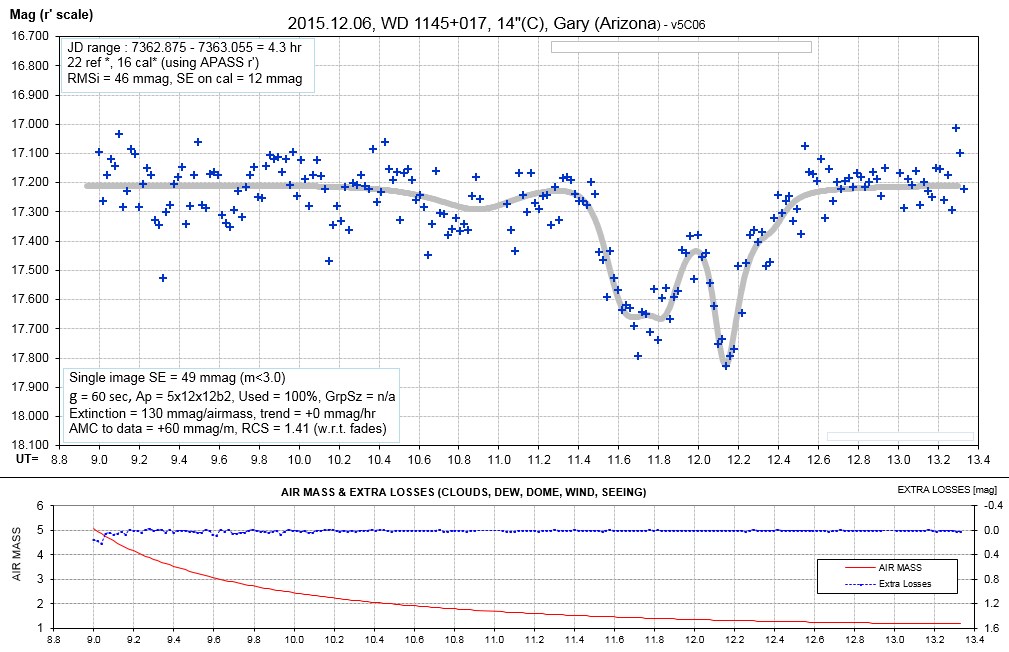
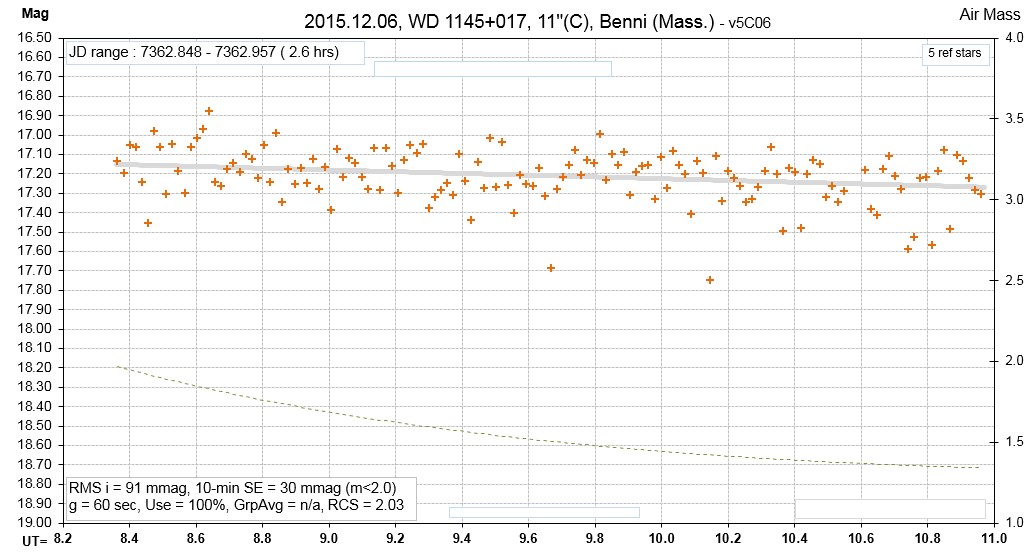
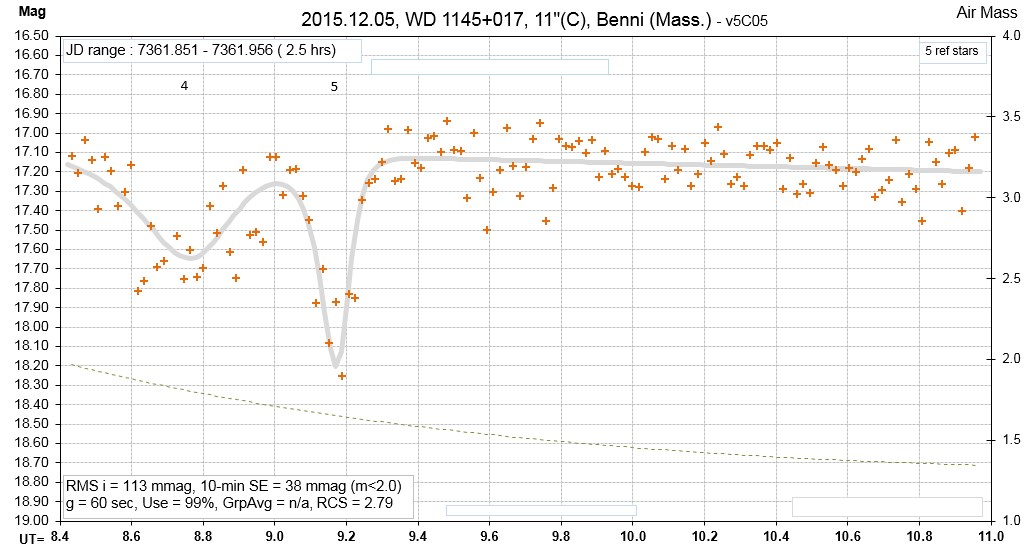
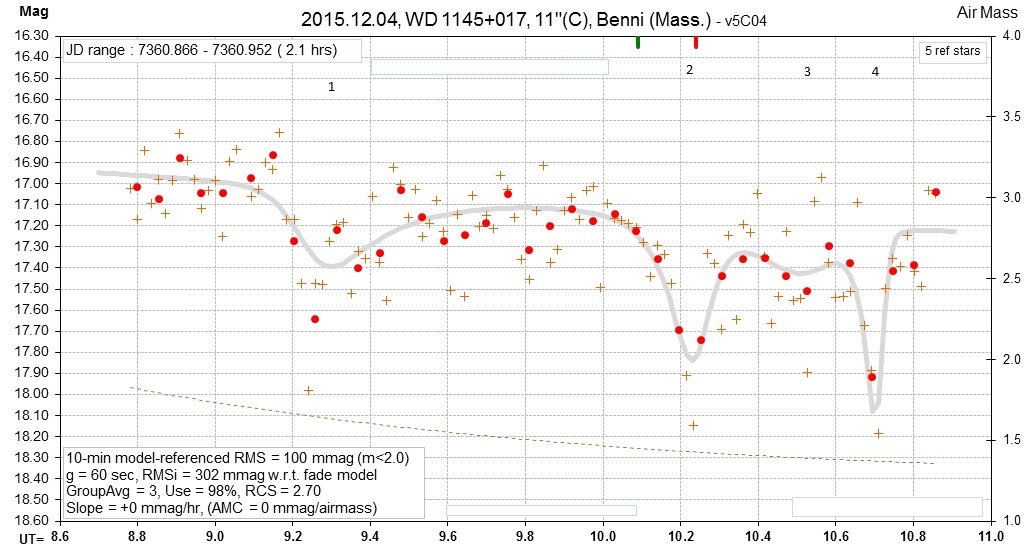
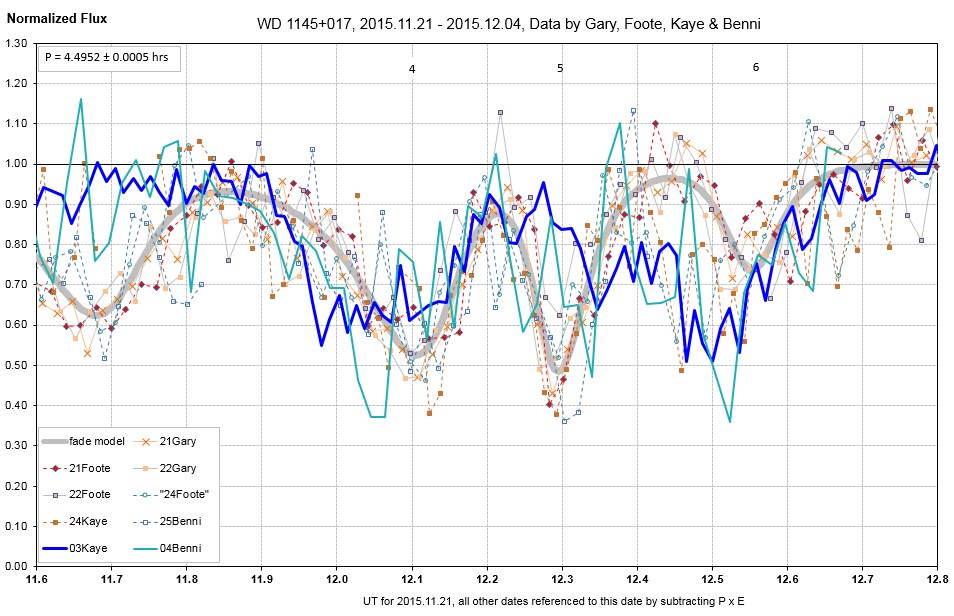

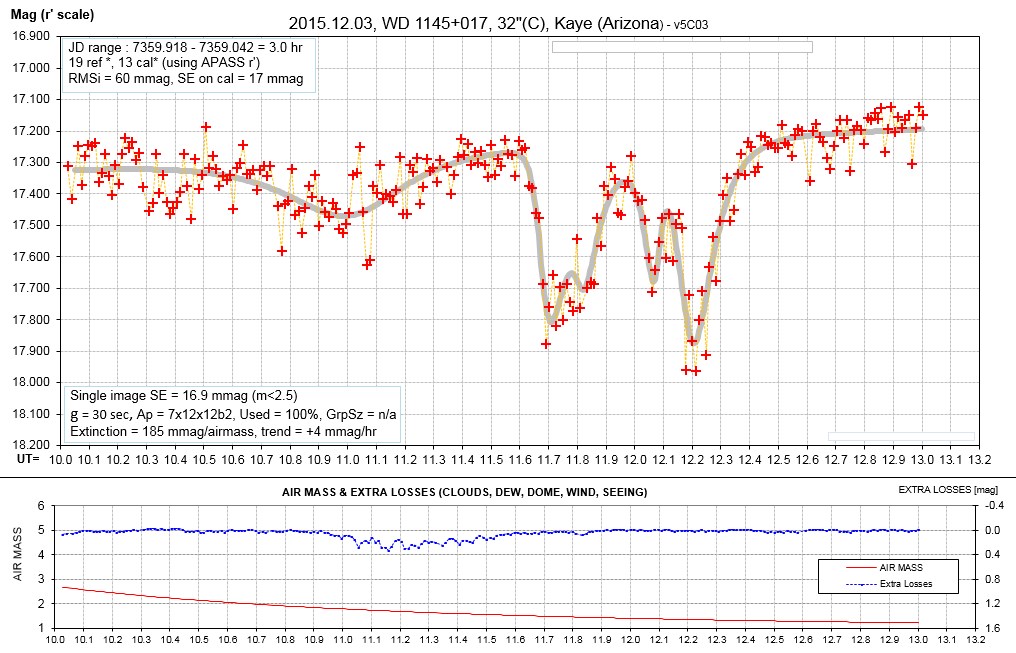

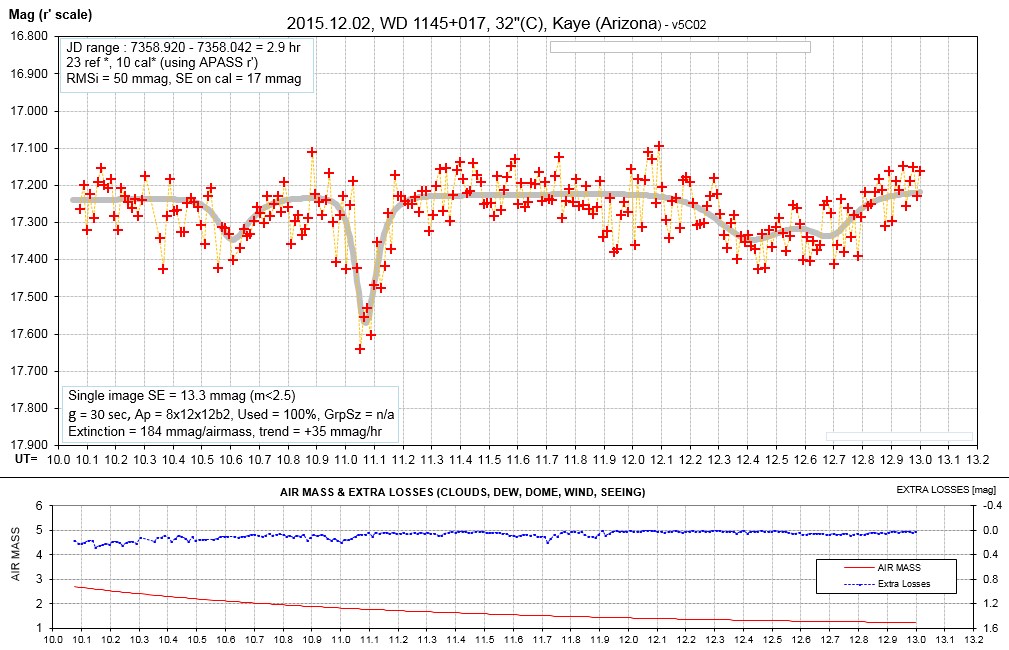

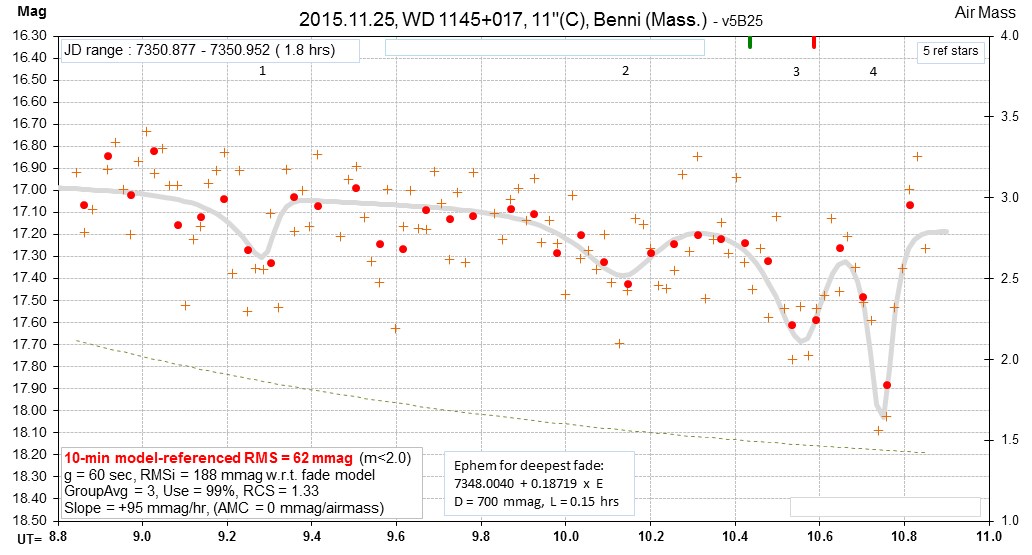
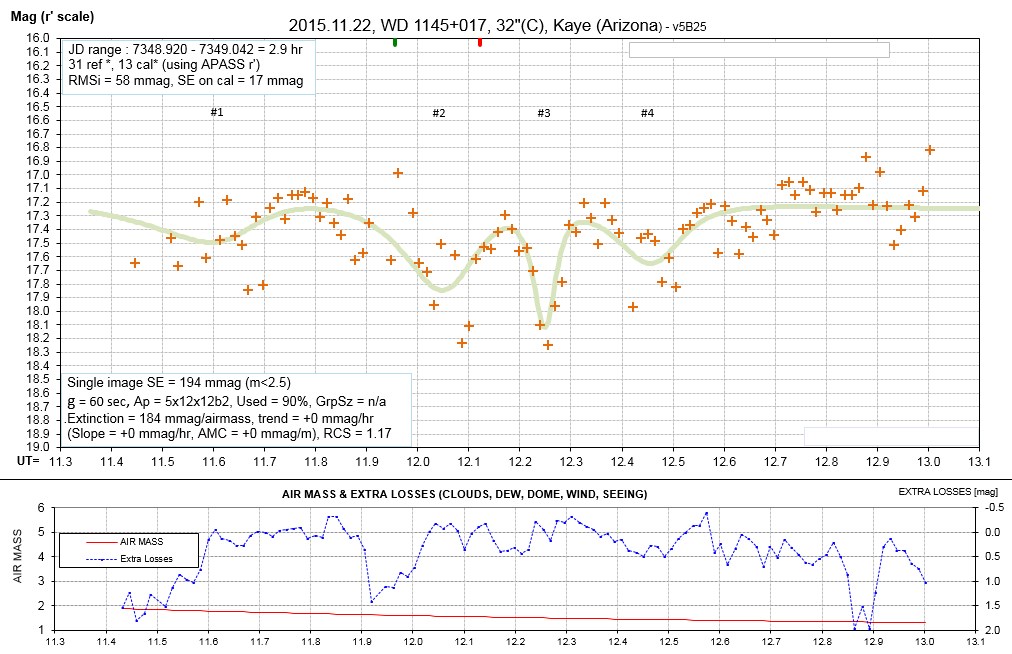
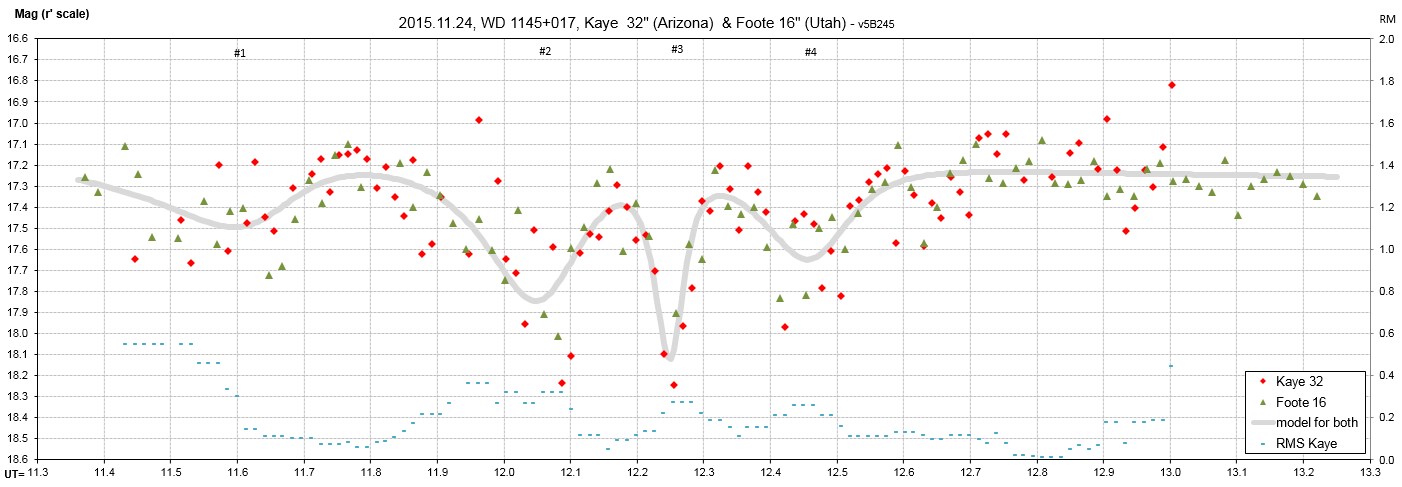
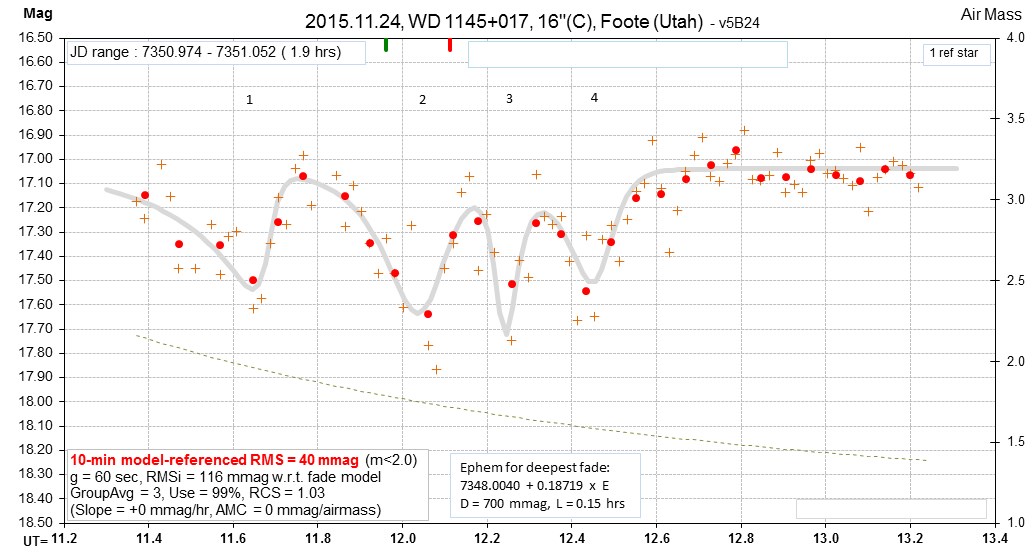
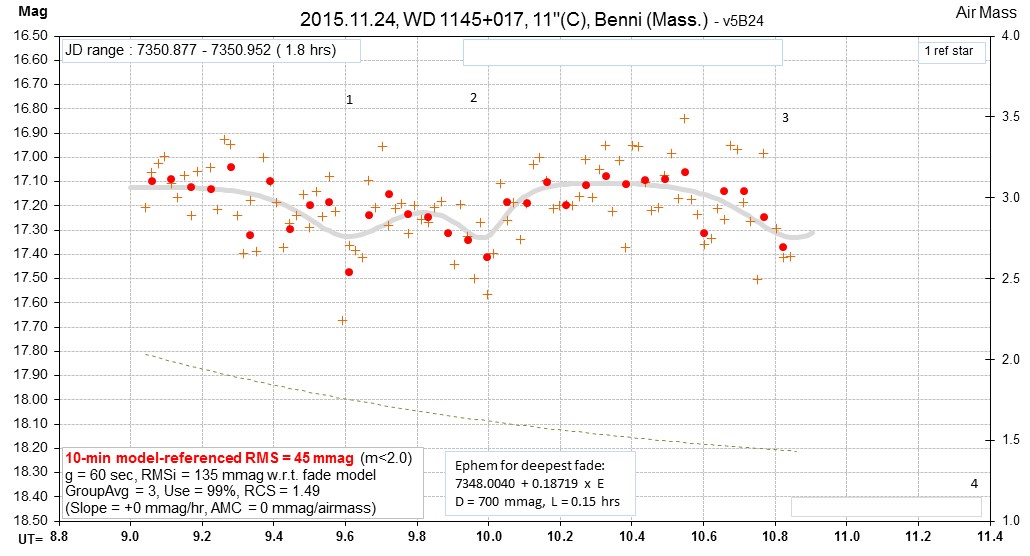

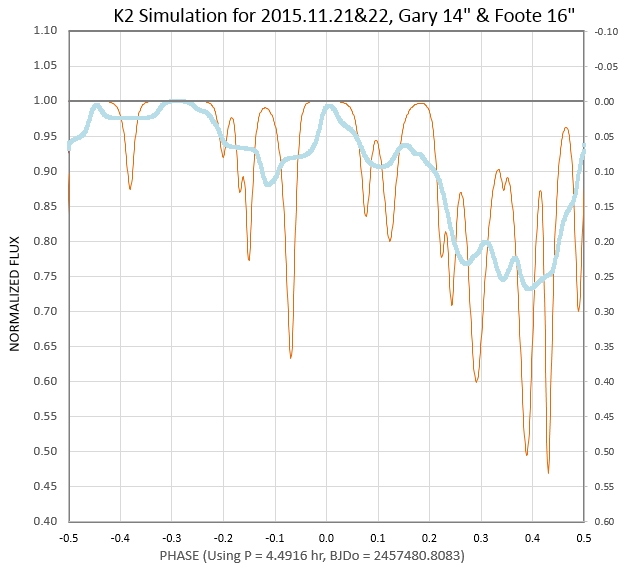
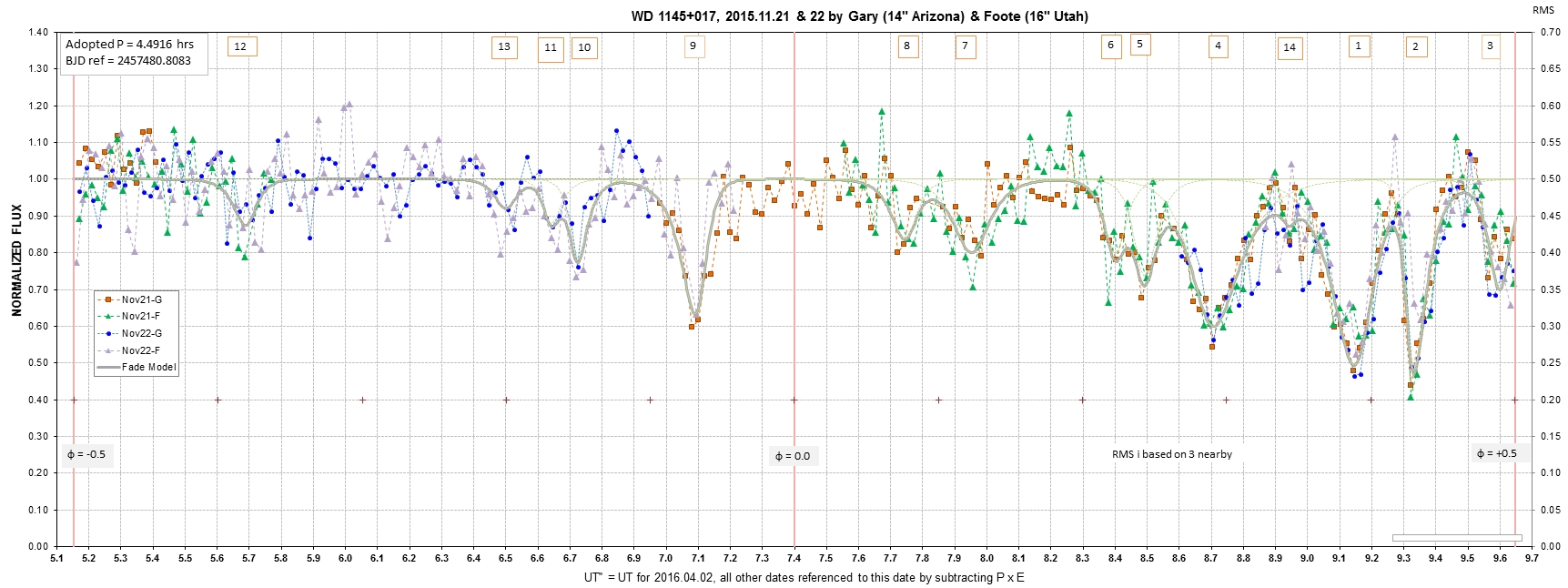
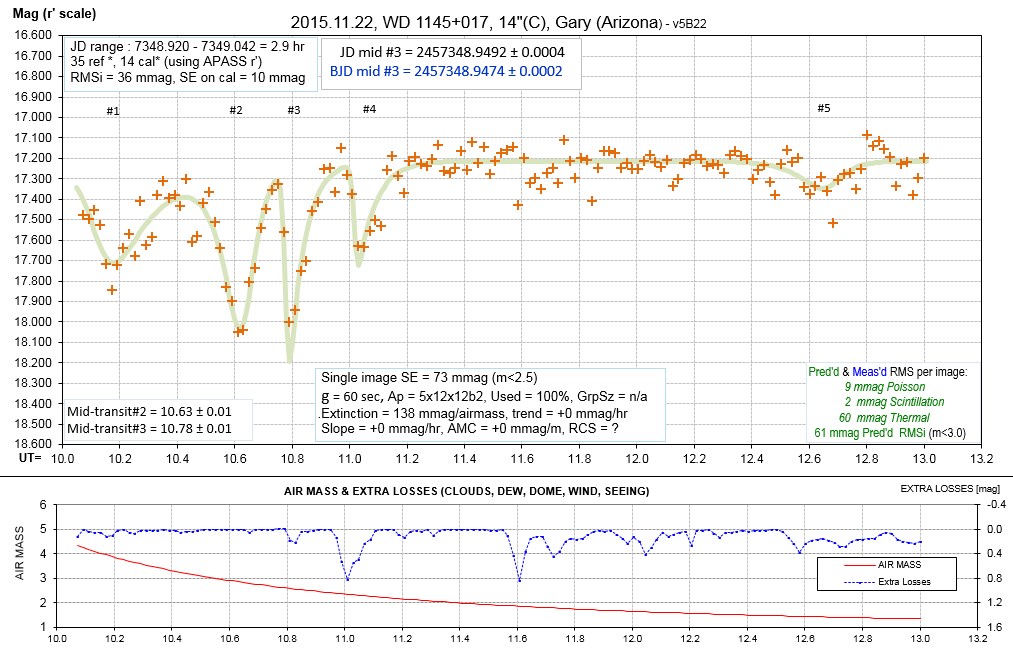



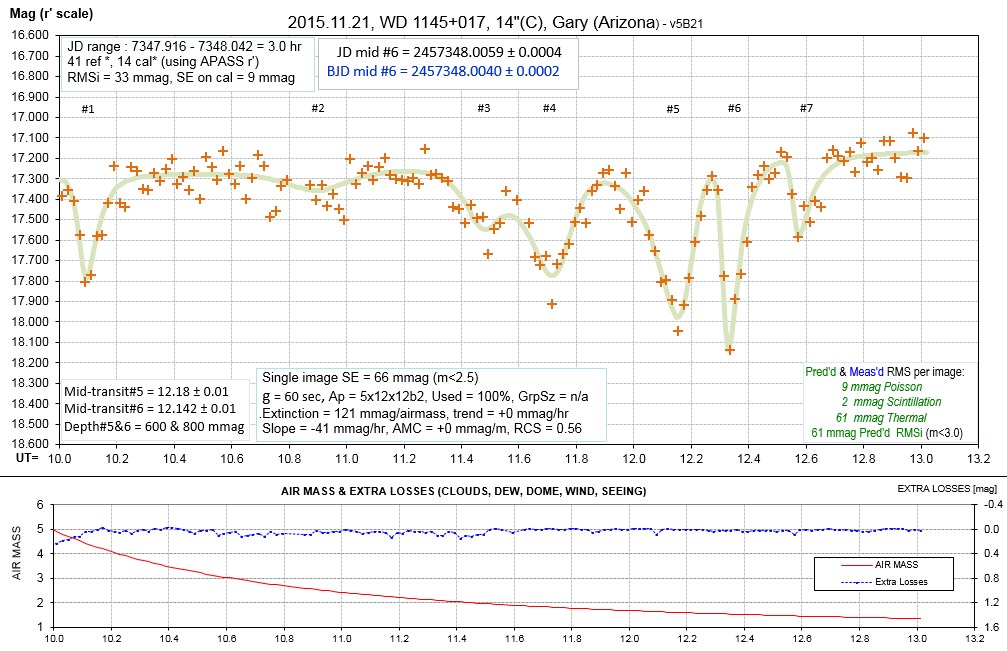
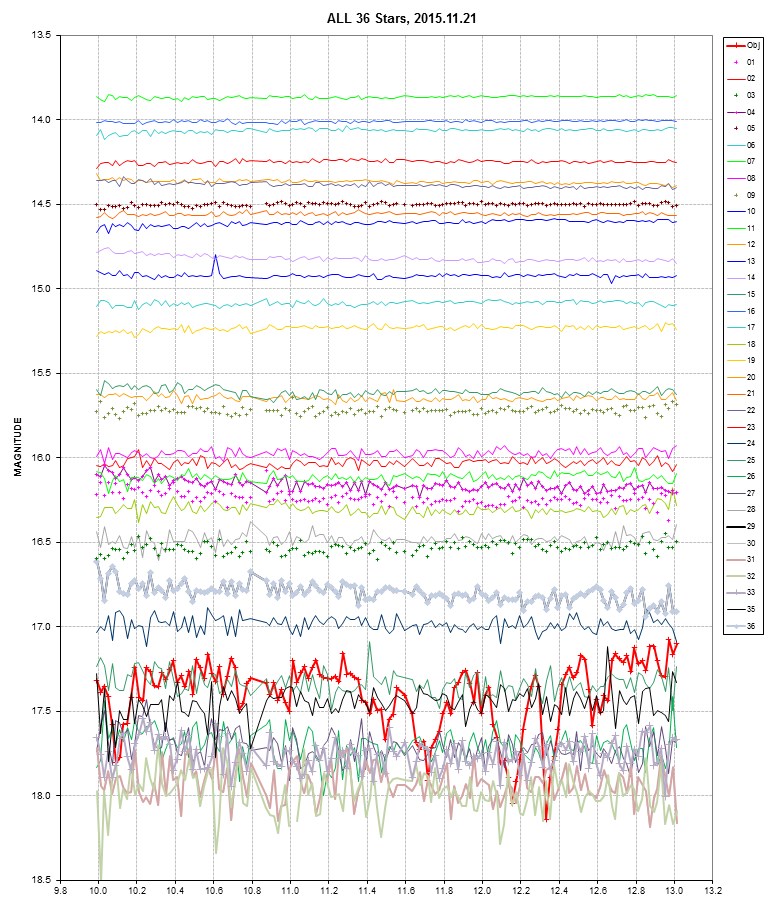
r'-mag vs UT for target (thick red trace) and 36 nearby stars.
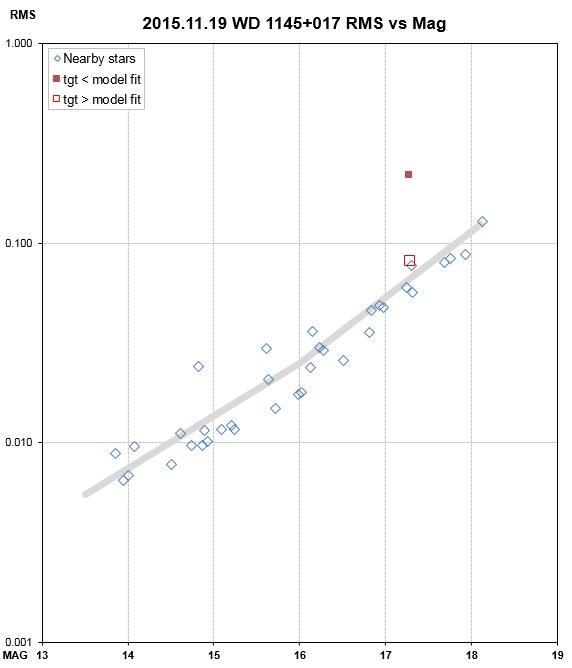
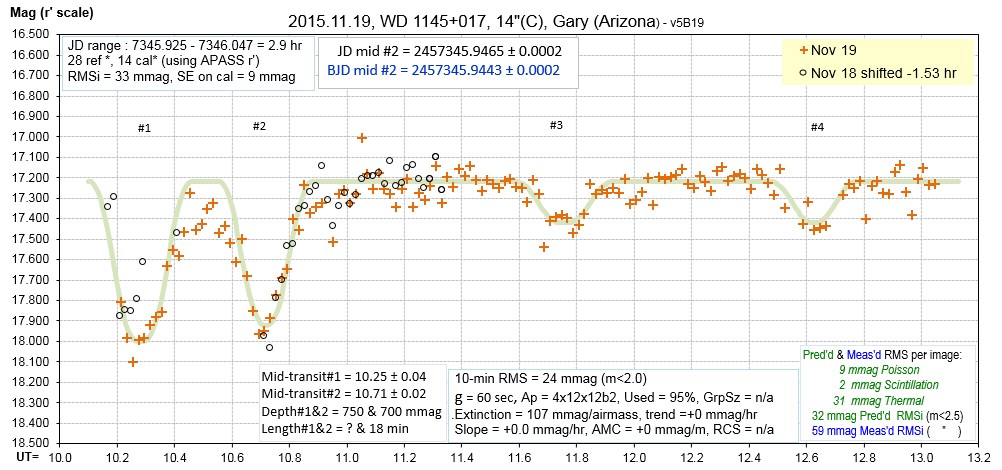
There are 4 fade features that are statistically
significant. `
This LC is consistent with the previous night's LC by showing two
transit features separated by ~ 1/2 hour (30 & 27 minutes). A
period of 4.495 hours could account for the #2 transit features of
this night and the previous one. The double-transit features
appear to shift -1.53 hours per day. Features #3 and #4 are ~ 200
mmag deep, with lengths ~ 12 minutes. I suggest the following
ephemeris: JD transit#2 = 2457345.9443 + E × 0.187292, JD transit
#1 = 28 minutes earlier.

The solid red square is for the WD on the
assumption that it is not variable. The open square is for WD on
the assumption that the LC model with 4 fade events (previous
figure) is justified. The open blue diamonds are for 35 nearby
(reference) stars.
The fact that the open red square for WD "belongs" to the
population of nearby (presumably non-variable) stars means that
the LC model, with 4 fade events, is compatible with the
statistics of all measured stars, and the 4-fade model is
justified on statistical grounds. If the open red square had
fallen below the population of nearby stars a case would have
existed that the 4-fade model was unjustified; i.e., that it
incorporated too many degrees of freedom for representing the WD
measurements.



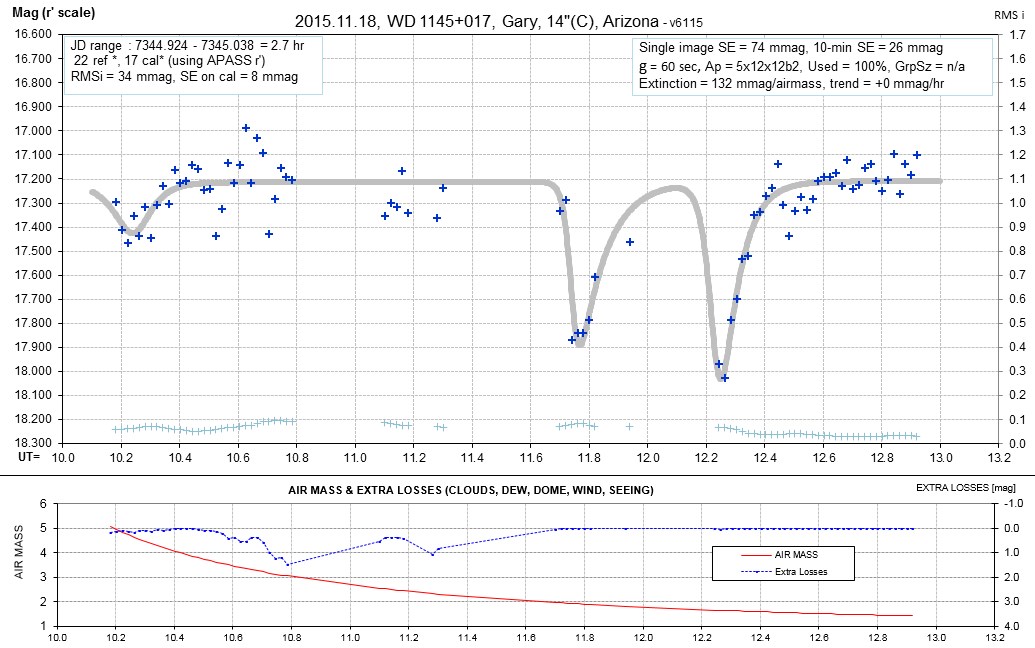
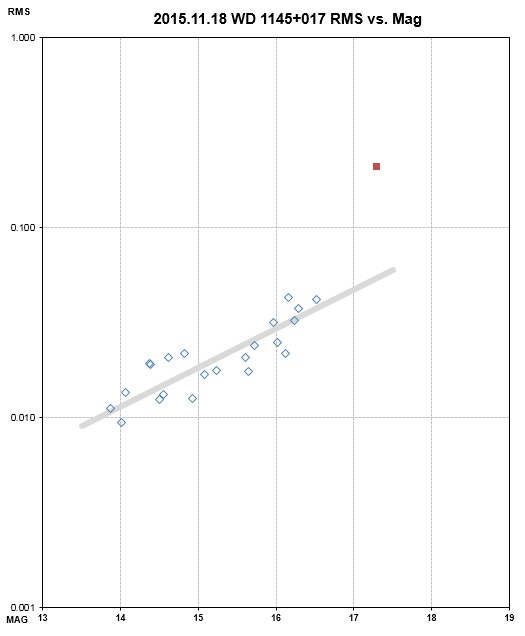
This 0.8-hr observing session was intended to assess the
presence of a transit that was predicted at 09.73 UT (if P = 4.6
hr) or 10.63 UT (if P = 4.5 hr), assuming that the transit-like
feature observed on Nov 08, at 12.21 UT, was real. It is my
opinion that no transit was observed on this date (Nov 15), but
the noise level is such that it can't be ruled-out.
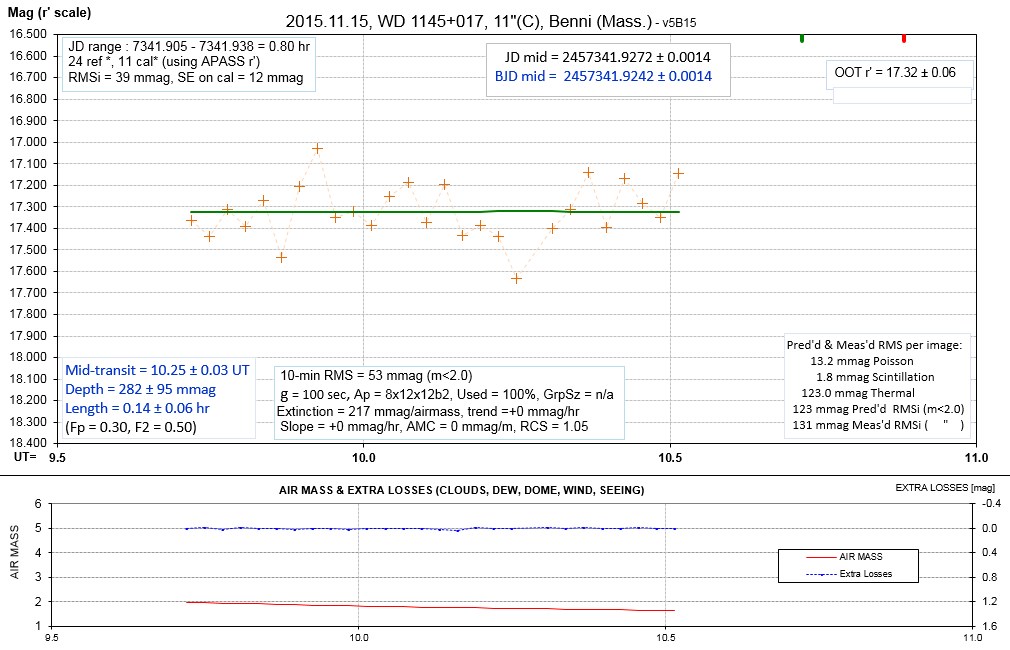
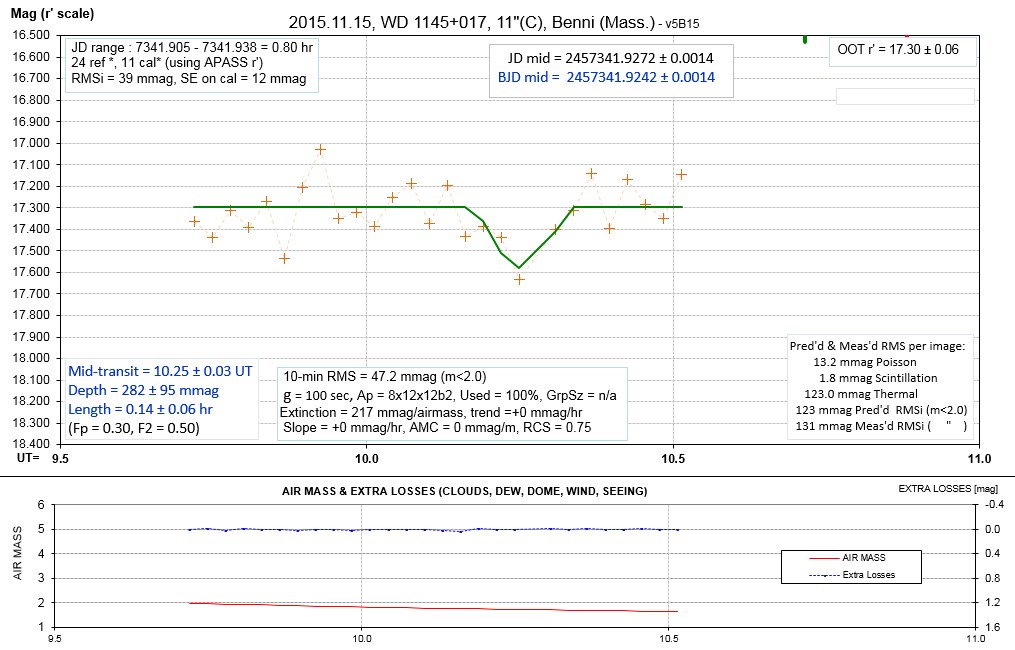
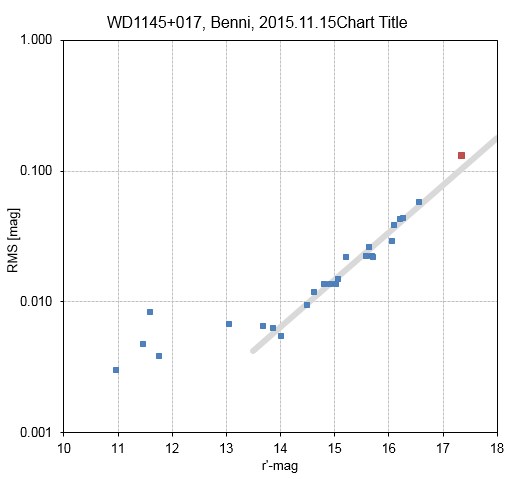
2015 Nov 11: Gary, 14"
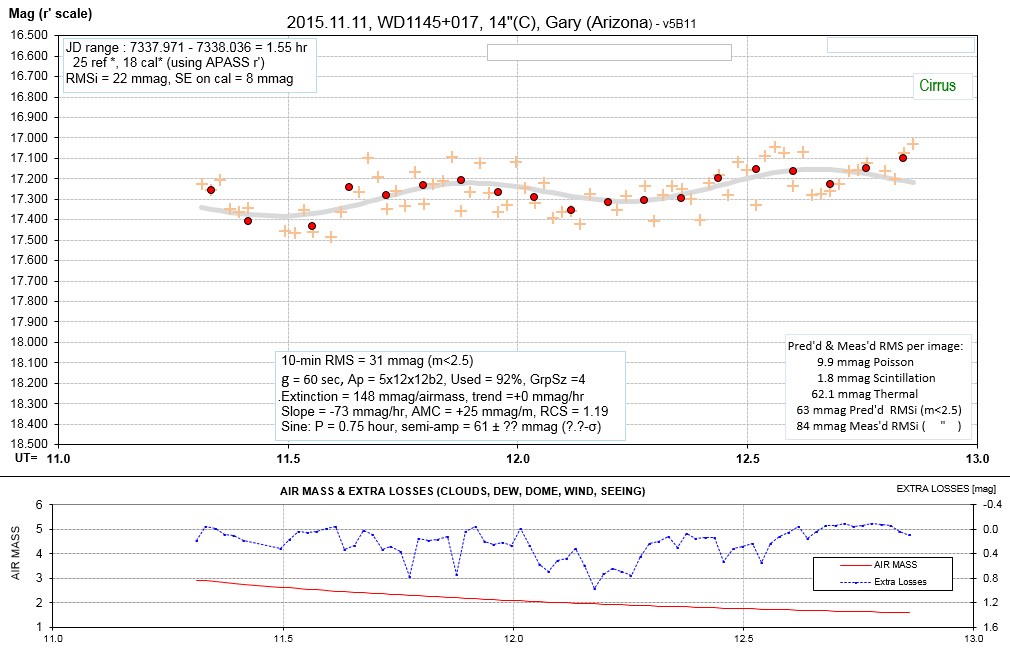
2015 Nov 08

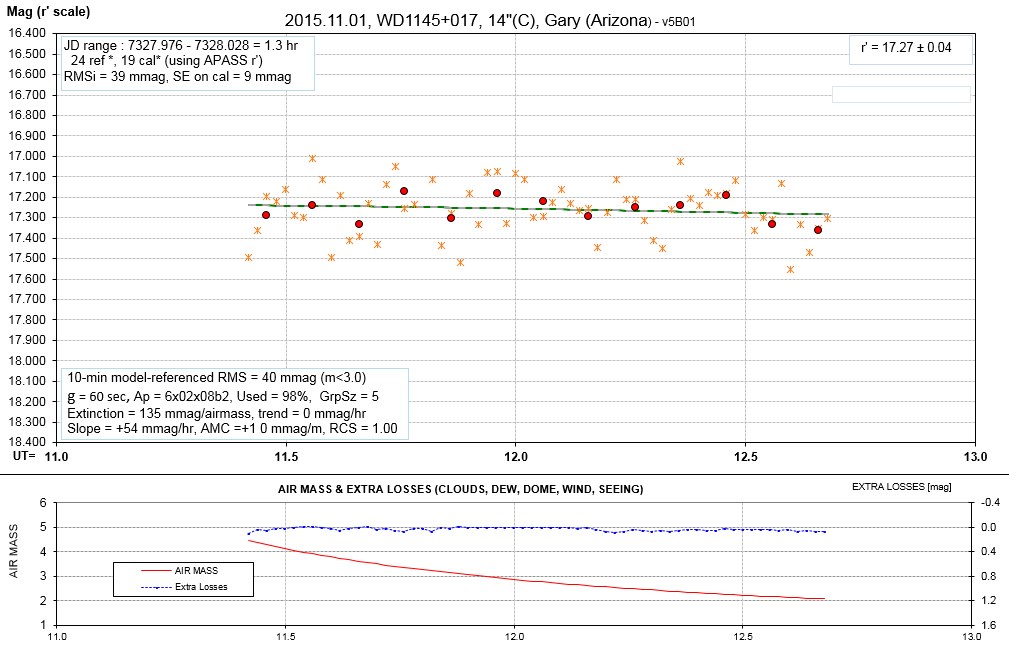
The team of amateur observers is:
Bruce Gary, Hereford, AX, Hereford
Arizona Observatory, 14" Meade SC, MPC G95
Tom Kaye, Sierra Vista, AZ, Raemor Vista
Observatory, 32" RC
Paul Benni, Acton, MA, Acton Sky Portal
(Observatory), 11" & 14" Celestron
Jerry Foote, Kanab, UT, Vermillion Cliffs
Observatory, home-built 16" SC
We Amateurs
"Don't Get No Respect"
I'm going to try to be as honest and fair as possible in the
following, while refraining from being critical. Indeed, I'm
going to give the "benefit of doubt" to the professional
astronomers associated with the WD1145+017 investigation.
Astronomers, as in most scientific disciplines, can be
divided into two major groups: observationalists and
theoreticians. But there's another way to categorize this field:
amateurs and professionals. Way back in the 1960's I was a
professional radio astronomer, but after a decade I transitioned
into the atmospheric sciences, where I was employed (by Caltech)
for 34 years. After retirement in 1998 I resumed a
childhood hobby of astronomy, as an amateur. Since retiring I've
collaborated and co-authored with professional astronomers for
the past 12 years, with ~ 37 publications. I'm therefore in a
unique position to comment on the state of pro/am collaborations
in this field.
WD1145 was discovered using the Kepler spacecraft during its
K2 mission. I presume that when it was recognized as an unusual
star system, probably in early 2015 by Dr. Andrew Vanderburg and
collaborators, it was clear that follow-up ground-based
observations would be needed to improve understanding of the
somewhat erratic dips in the K2 data. Fades of ~ 1% appeared to
last about an hour in the K2 data, occurring at 4.5 intervals,
and the amplitude would vary on weekly timescales within the
range ~ 0% to 2% during the 80-day Kepler observations. WD1145
is a very blue 17th mag star, so I'm guessing that the
professional astronomers who shared this information assumed
that only professional observatories could provide follow-up
ground-based observations.
Some professional astronomers used to be amateurs, but
probably most haven't been. Those practicing professional
astronomers who have never been an amateur must have a low
opinion of what amateurs are capable of. The truth, for those
professionals who are still clueless about this, is that amateurs
today are capable of professional quality work for specific
categories of observing and analysis. I tried to describe this
in my book Exoplanet Observing for Amateurs, citing as
an example the monitoring of exoplanet transits. The
rule-of-thumb for when amateurs may be able to contribute
something of value is based on the concept that amateur
telescope time is free, and amateurs are willing to observe for
long hours if they are motivated, so: a task may be suitable for
amateurs when many hours of monitoring a star's brightness is
required (as illustrated by the role of AAVSO).
WD1145 is an example of a star whose brightness changing
behavior is well-suited to amateur observing since many hours of
observations are needed to determine behavior patterns. Why, I
ask, didn't the professional astronomers who knew about WD1145,
and the need for follow-up observations, ever consider asking
for help from us amateurs?
In 2015 February, when I estimate that the professionals
were formulating follow-up observations, they chose to pay for
expensive time on large aperture professional telescopes instead
of contacting advanced amateurs to inquire about the feasibility
of far more hours of (free) observations. If they had contacted
me in February of March we could have observed the target when
it was high in the sky and observable all night, as was done by
the professional telescope observers. Instead, we amateurs
didn't know about WD1145 until the arXiv article appeared in
late October. By then the target could only be observed for ~
1.5 hours, before sunrise, when it was low in the sky, suffering
from high air mass extinction (worse for a blue star due to
atmospheric Rayleigh scattering). In spite of this handicap, we
amateurs achieved in 2.5 months what the professionals failed to
do a half year earlier during a similar interval under far more
favorable circumstances, and with larger apertures.
When I contacted Dr. Bryce Croll to ask if I could help
support him with his planned future observing project, starting
in 2016 February, he just wanted a vague assessment of activity
level, and possibly an ephemeris for dips, in late January. He
had no idea that I would be able to do more than that. I was
more optimistic, since I had recently measured the phase-folded
rotation light curve of a 19.6 mag Trojan asteroid, and showed
that as it rotated its brightness varied with an amplitude of
0.23 mag. My first observation of WD1145, Nov 1, established
feasibility, and a week later (Nov 8) I acquired a 35% dip with
a trailing tail that demonstrated a capability with far more
scientific usefulness than was initially envisioned. The next
observations showed 3 dips, then 5 dips, and by then it was
clear that a 14" aperture telescope was showing a different
level of dip activity than had been seen by the professional
telescopes a half year earlier. I recruited 3 more advanced
amateurs to observe, and on Nov 21 two of us corroborated on the
presence of 11 dips during a 3.2-hour observing interval. The
only encouragement we got from a professional astronomer was Dr.
Saul Rappaport, a theoretician; there was minimal e-mail
acknowledgement of our work by anyone else. But I knew that our
amateur team was capable of doing what the professionals were
planning to do months later, under more favorable conditions and
with larger telescopes, so we amateurs moved forward with
observing whenever skies permitted.
By mid-November we saw evidence for "drifting" of dip
features to earlier times than the published principal orbit
period could accommodate. At Tom Kaye's suggestion we began
making "waterfall plots" to convince our lone professional
collaborator, Dr. Rappaport, that drifting was occurring. After
about 3 weeks we convinced him that the dips drifted, and thus
began a new focus of our observational/theoretical
collaboration. Dr. Rappaport came up with a novel idea that the
parent asteroid was filling its Hill "sphere" (a football-shaped
volume), and fragments that broke off at the L1 end would be in
orbits with periods that would produce the drifting that we had
found. After this, it was clear that our small team of 4 amateur
observers and one theoretician may have "cracked the case" of
WD1145.
Returning to my original question: Why didn't the
professional astronomers who knew about WD1145 a year ago invite
us amateurs for help? I'm faulting observational professionals,
for they should have known that large aperture telescopes
weren't necessary for follow-up observations. We amateurs could
have done a much better job last March, when the target was high
in the sky and observable all night, compared with the
handicapped conditions in November. Our telescope time is free,
and we could have obtained many more hours of observations than
were obtained by the few large aperture professional telescopes
that had been used during last March, April and May. The article
that we're submitting to ApJ (2016 Jan 26) could have
been submitted last summer if we had been asked to help. Did
they neglect us because they were unaware of our capabilities?
Or maybe because collaborating with amateurs is a career killer?
I don't know the answer, but I hope that professional
astronomers will gradually learn to appreciate the potential
value of pro/am collaborations because we have a lot to offer,
and the price is right.
And in case any amateurs are reading this, and wondering
about collaborating with professionals, I have some advice:
Don't!
Related Links
WD1145 LC observations for date interval
2016.01.17 to 2016.07.13: http://www.brucegary.net/zombie/
(PW protected until article is accepted at MNRAS)
WD1145 LCs for 2015.11.08 to 2015.12.16 on web
page created for Bryce Croll link
Some observing "good practices" for amateurs (book):
Exoplanet
Observing for Amateurs
Master
list of my web pages & Resume
This site opened: 2015.08.25 by webmaster B. L. Gary.